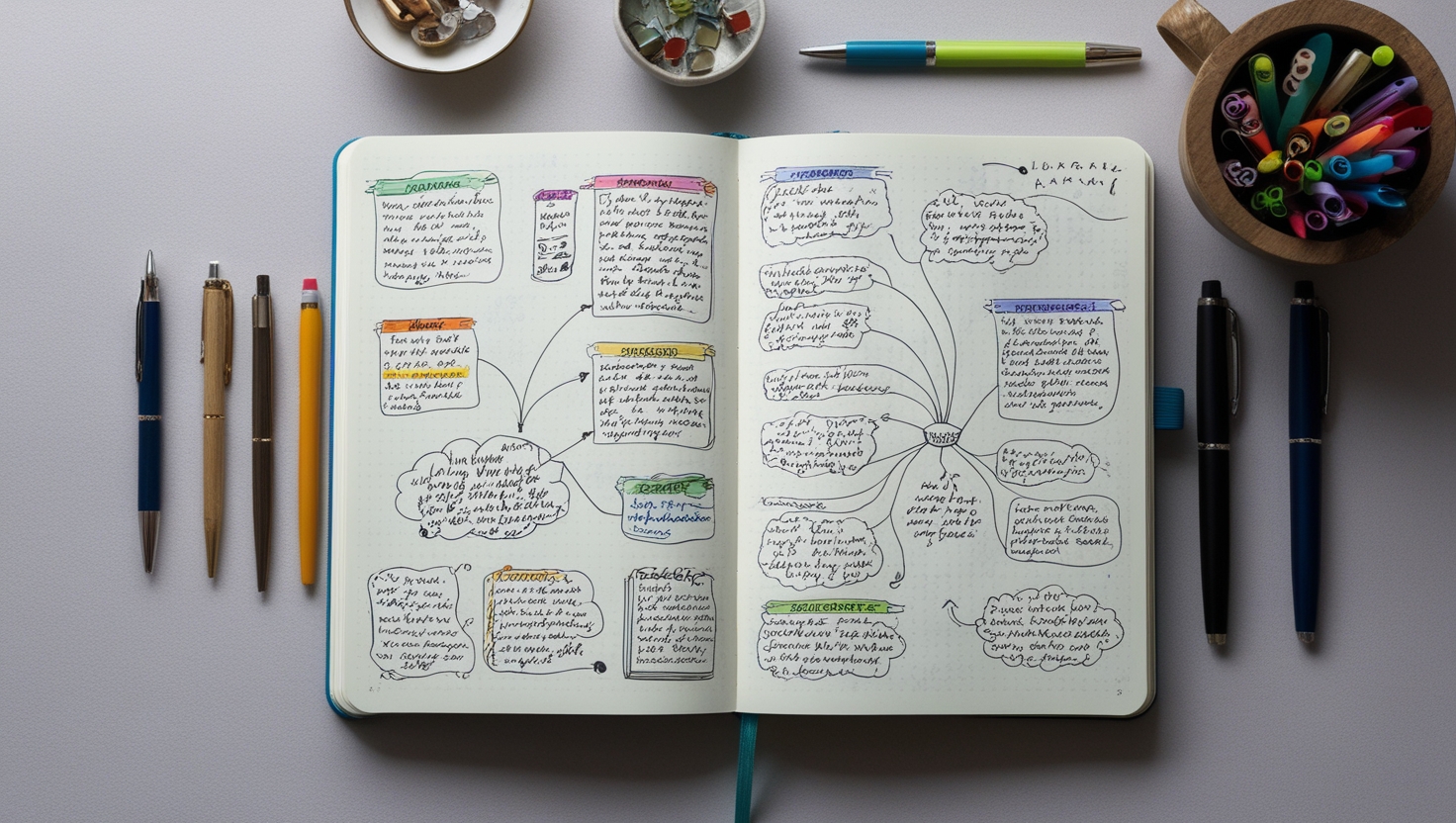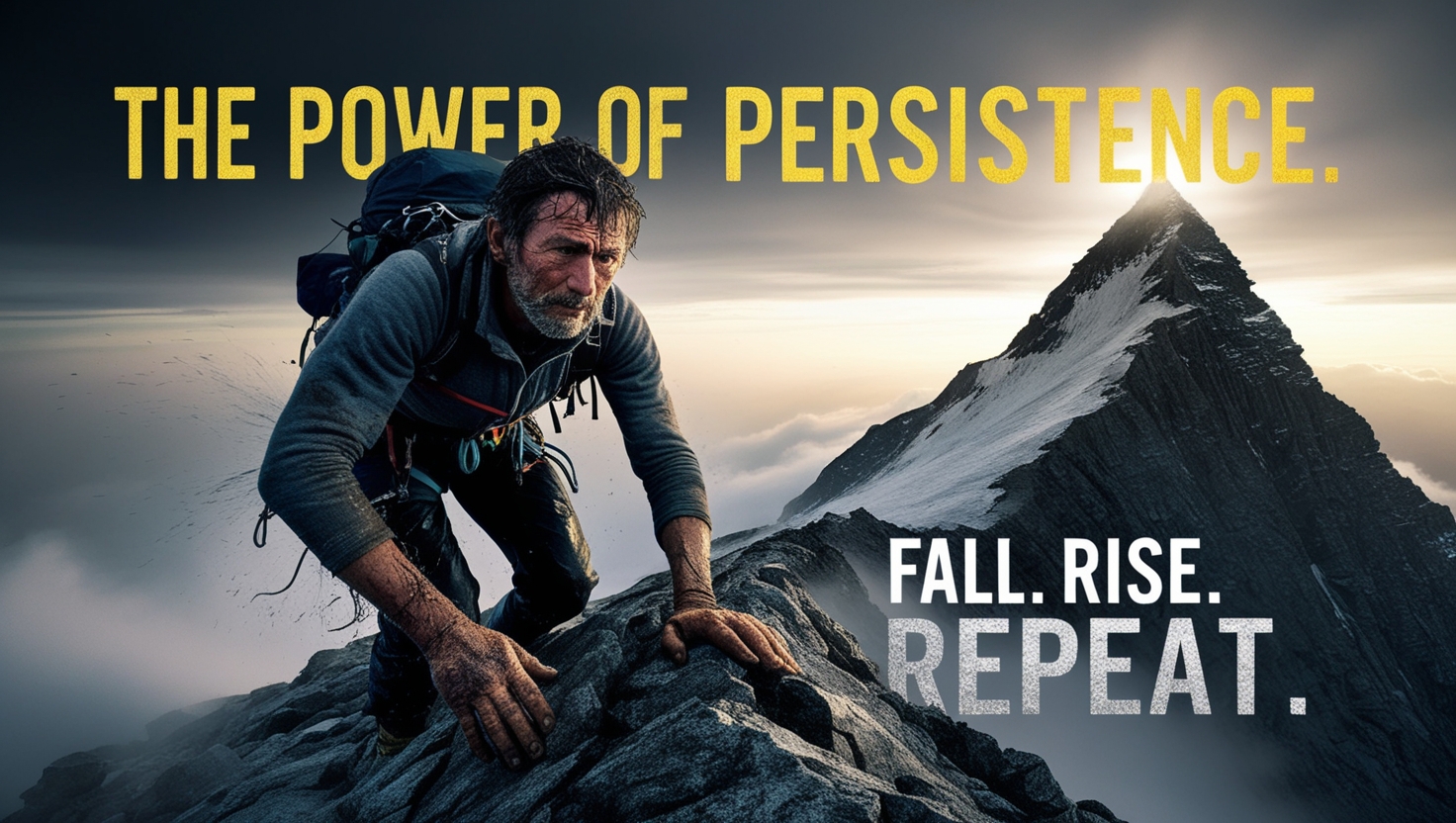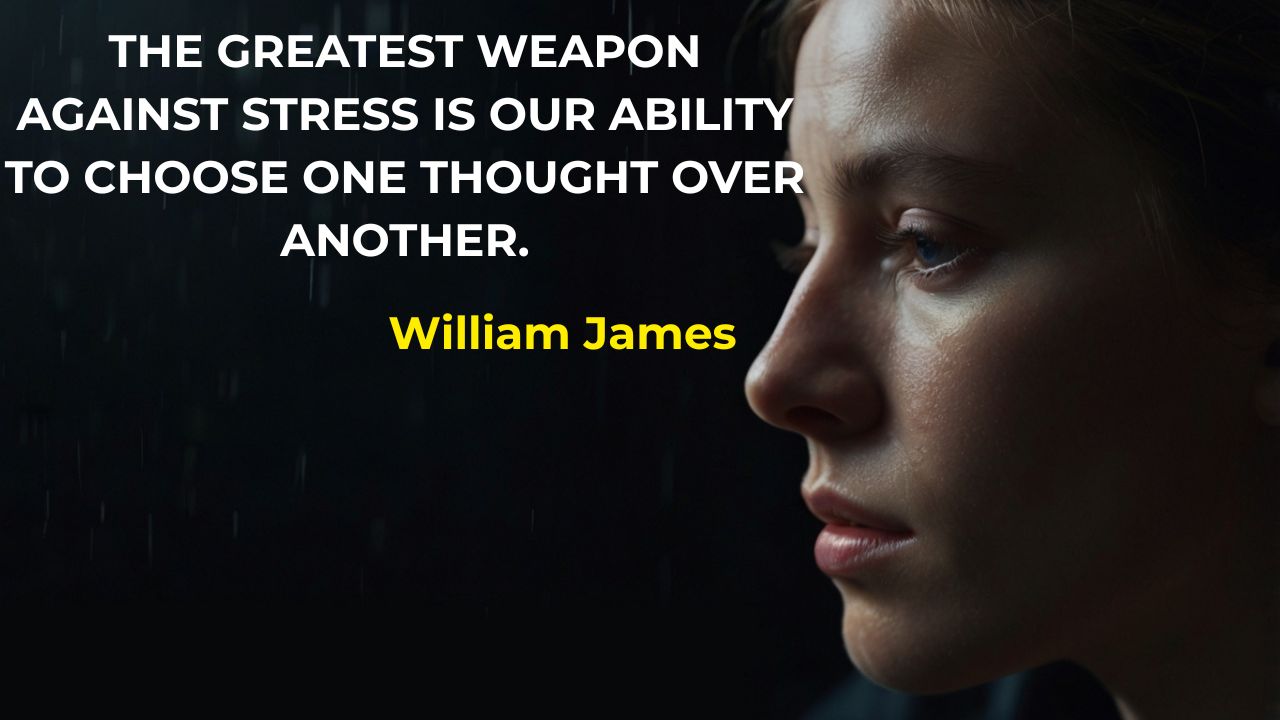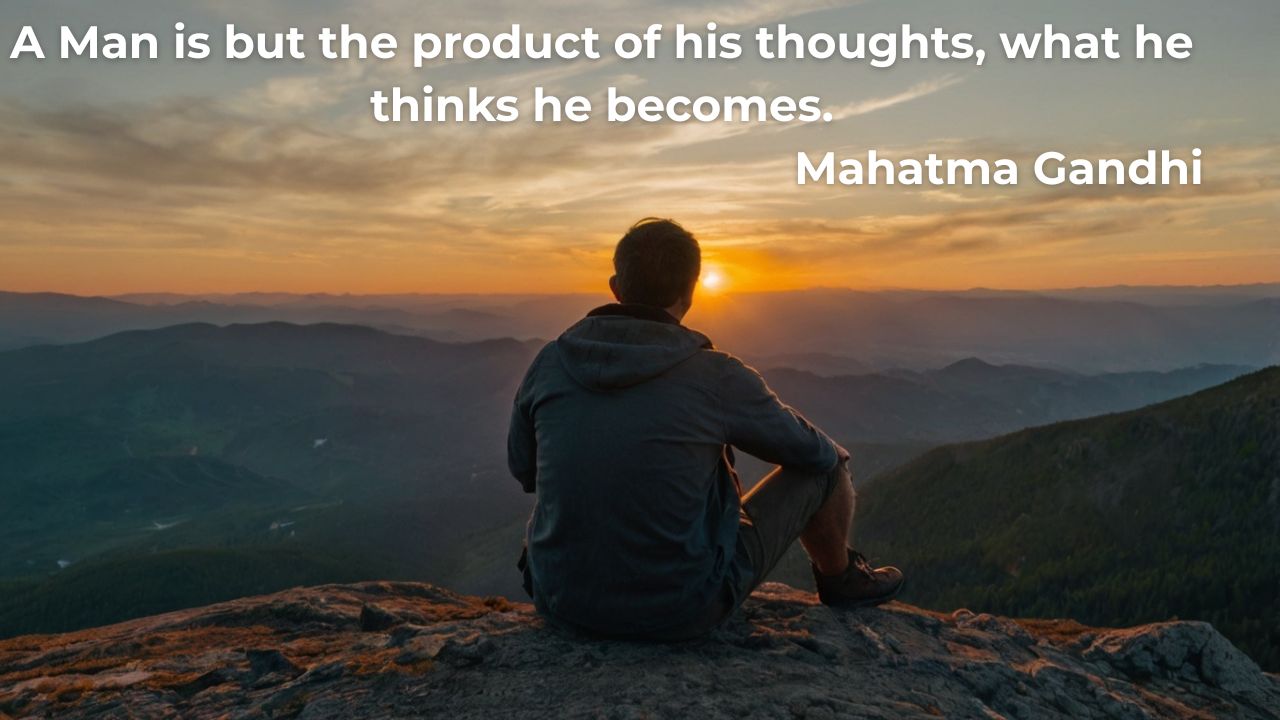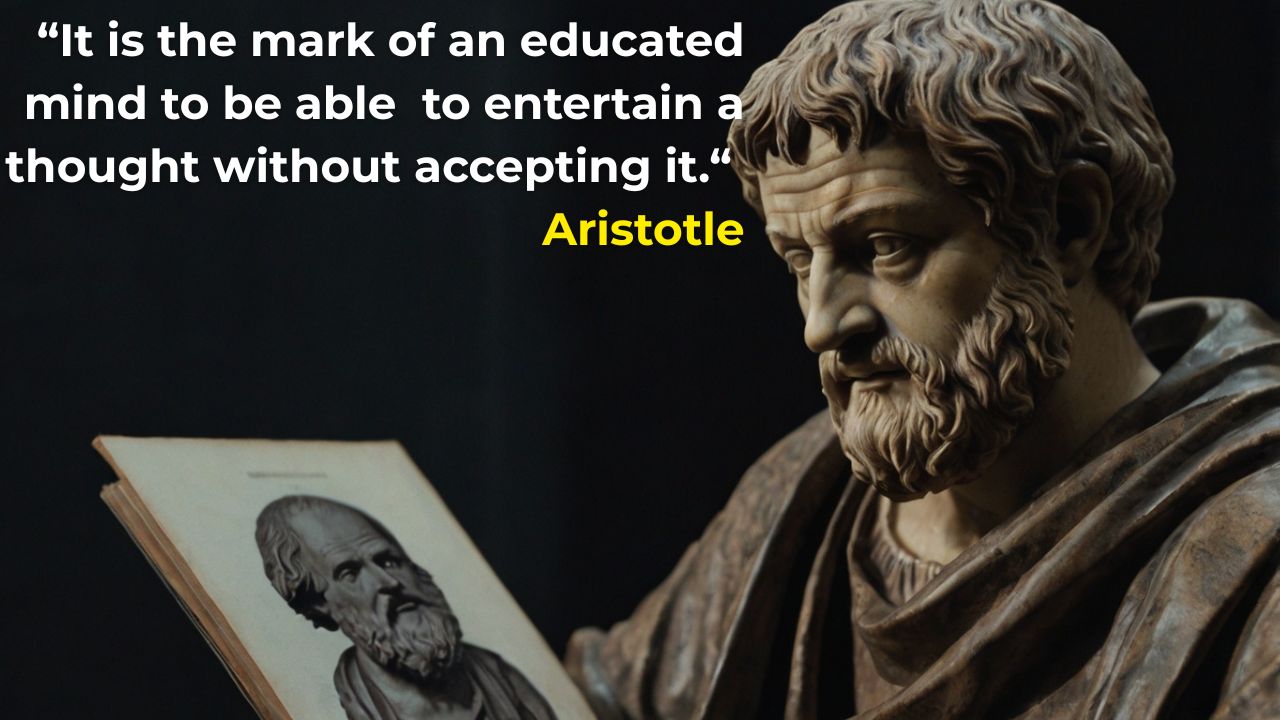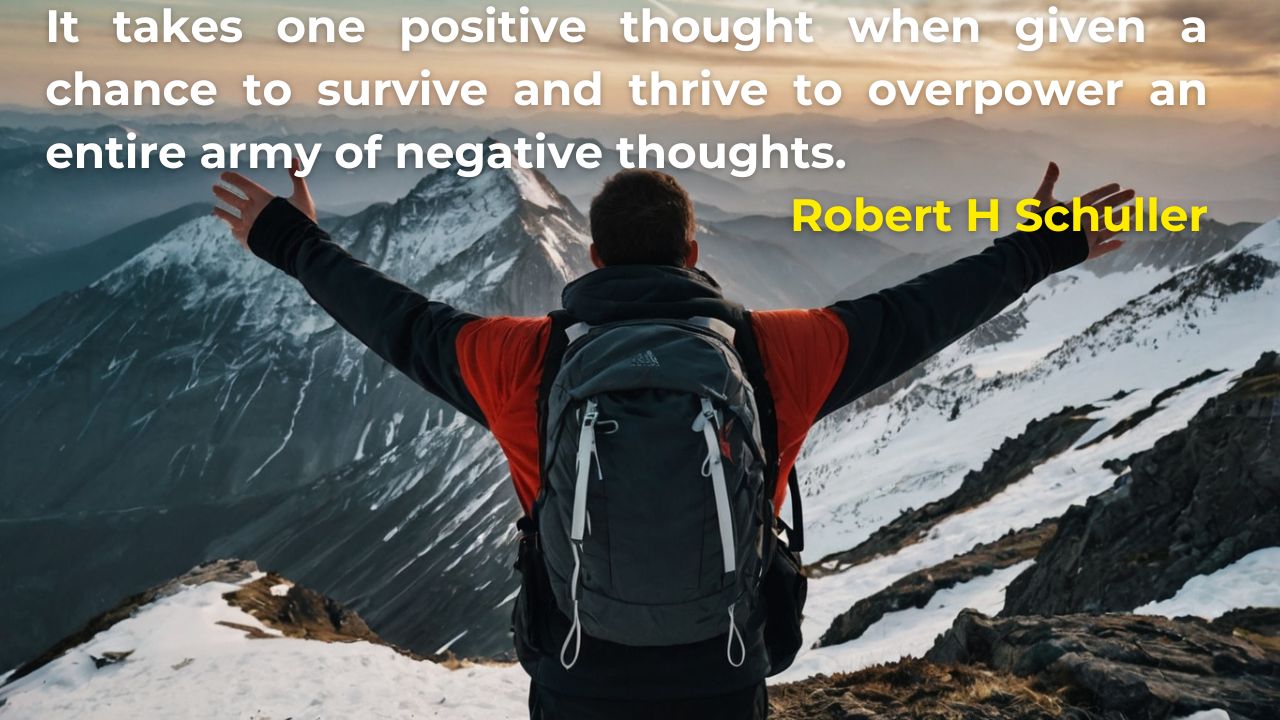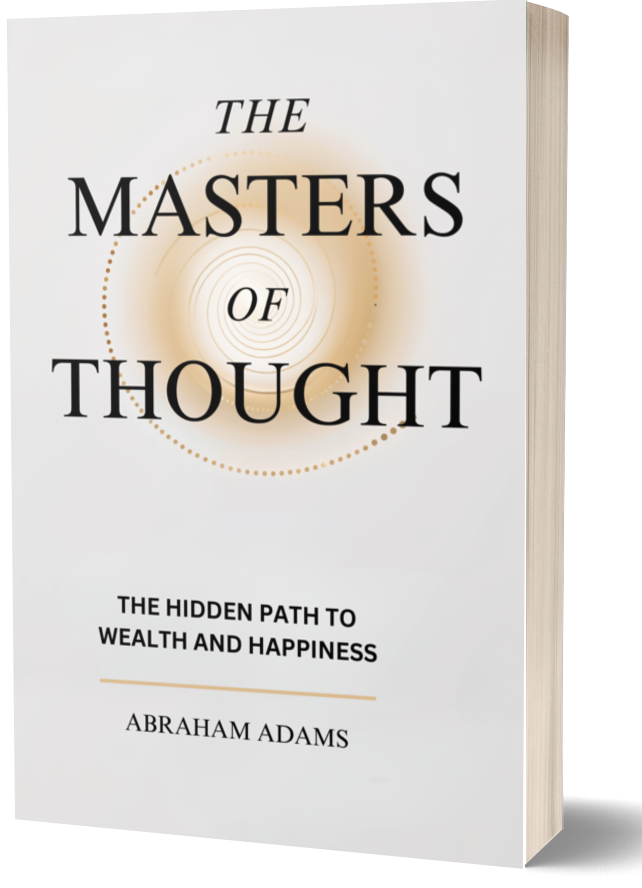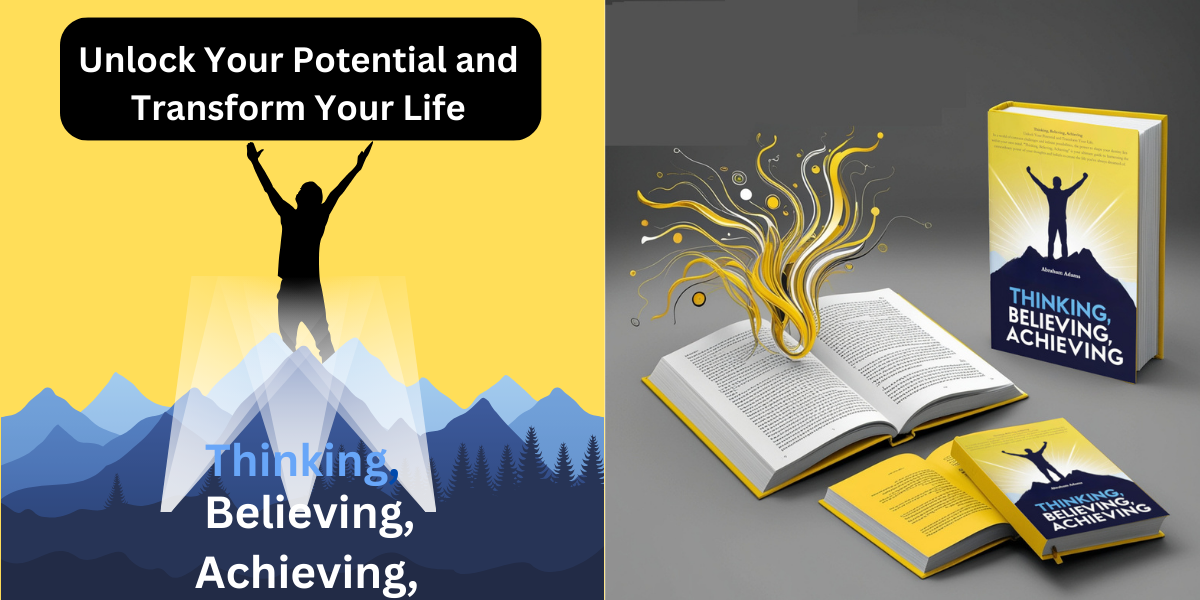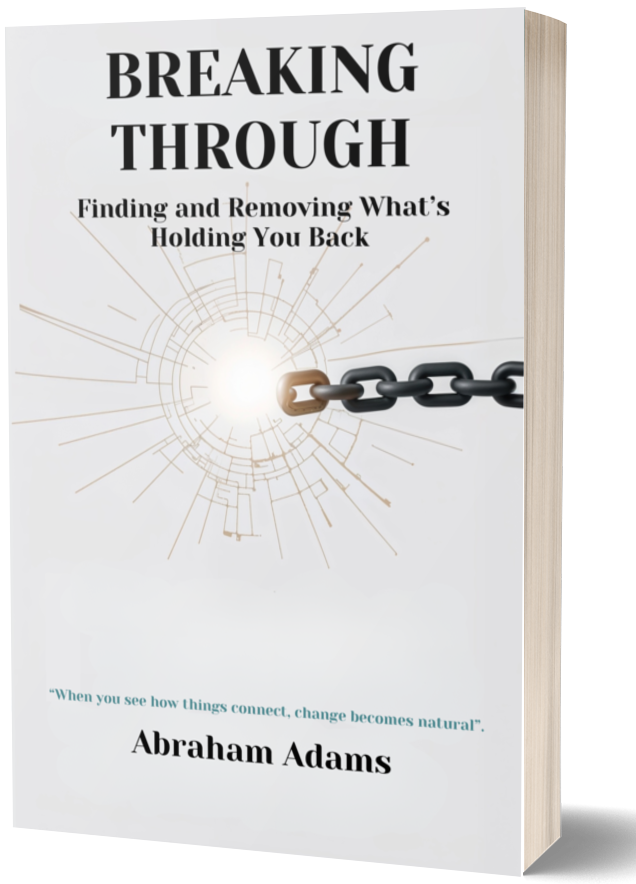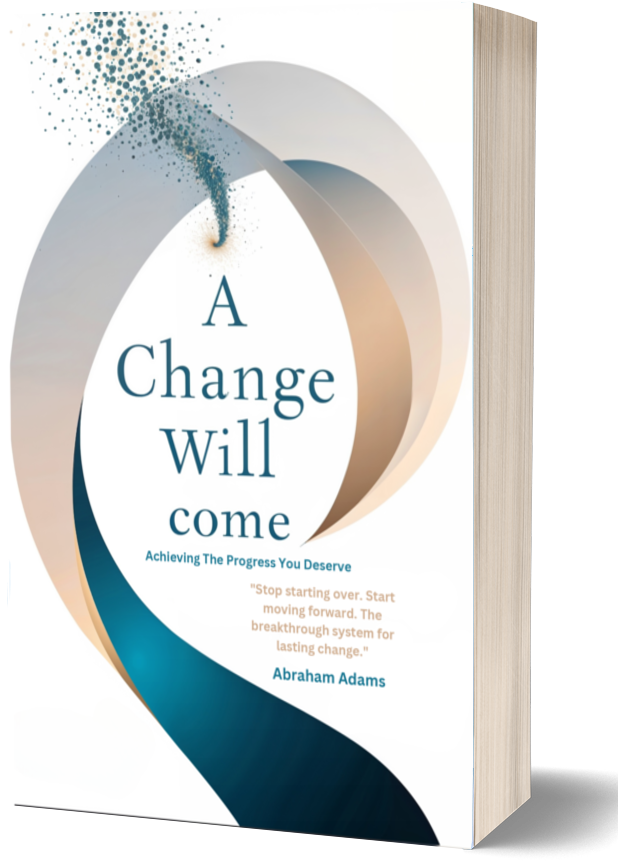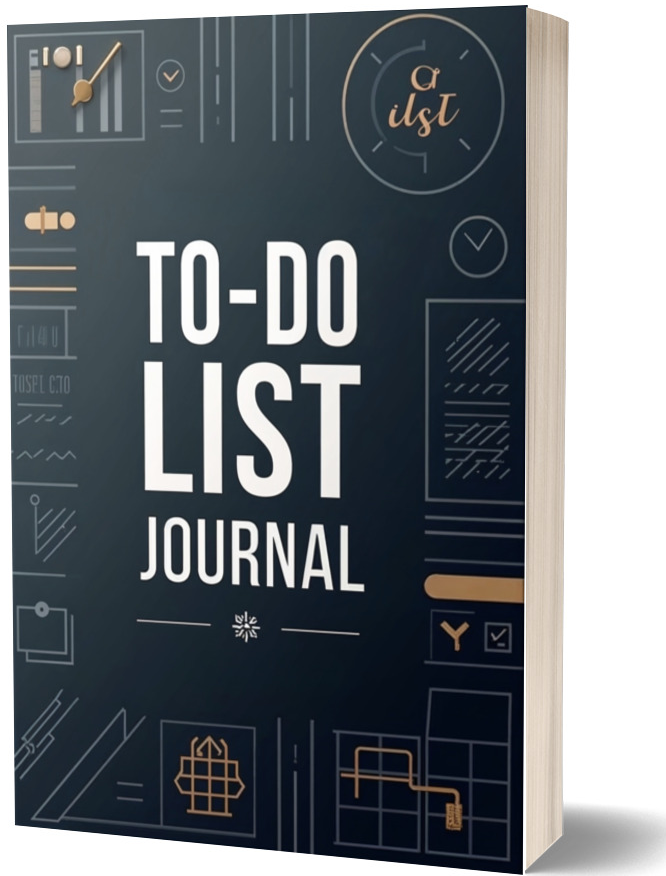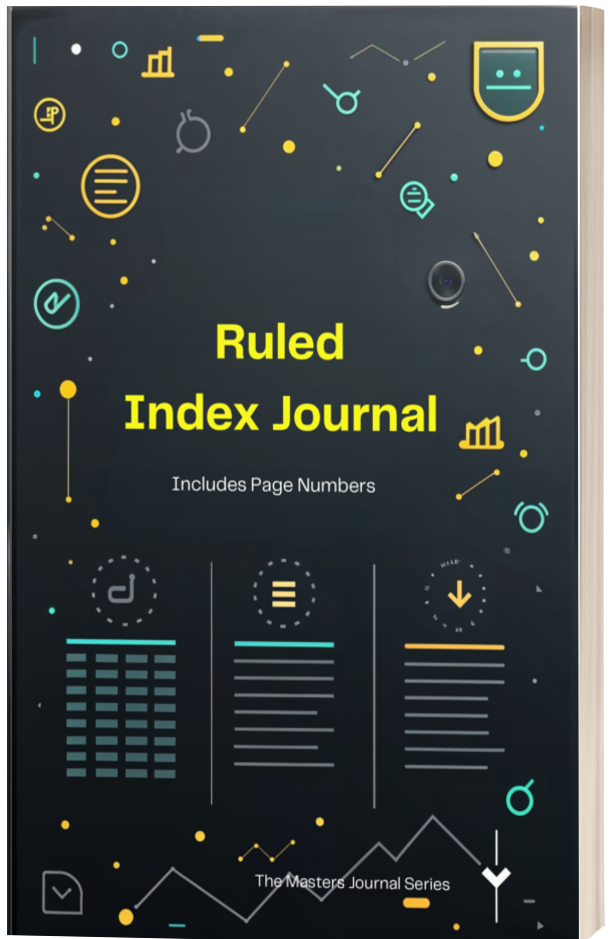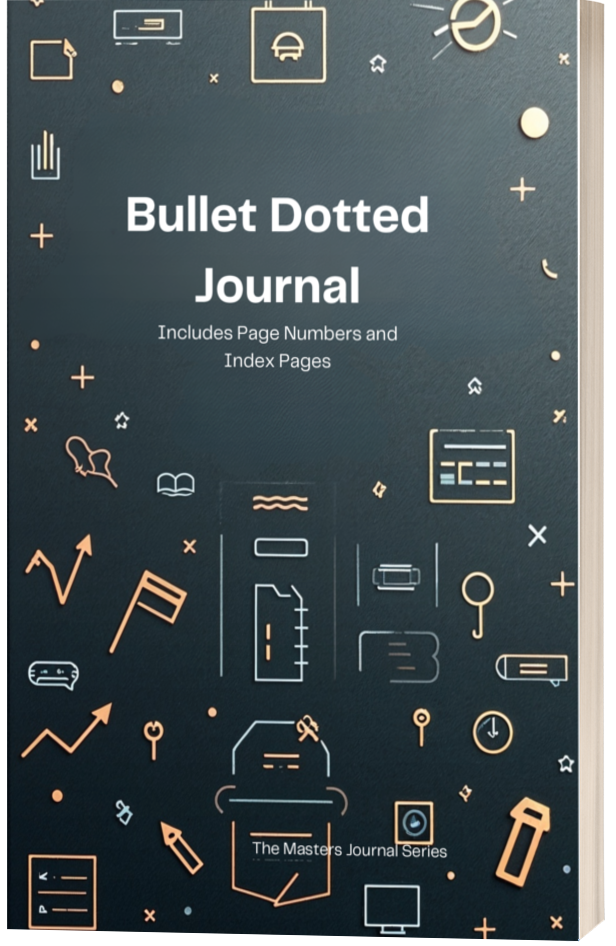Super User
The Journal Trap
The Journal Trap: How Writing About Your Problems Keeps You Stuck
(And The Simple System That Creates Change)
The $3 billion journaling industry has a dirty secret: most people who journal today will still be dealing with the exact same problems a year from now.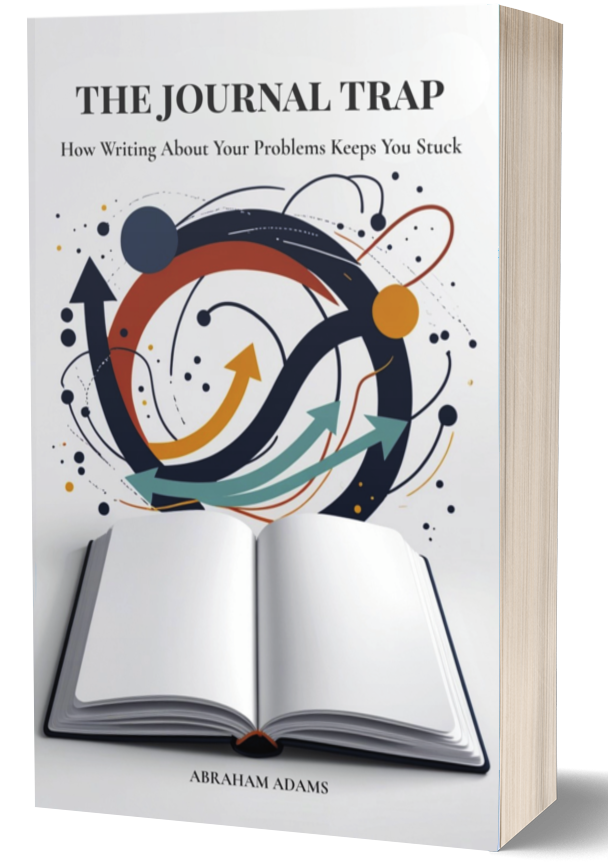
Sarah bought her first journal at 22, drawn by promises that successful people journal and that writing was the key to clarity and self-improvement. Three notebooks later, she was still anxious, her boss was still difficult, her relationship was still complicated, and her finances were still stressful. Five years and twelve journals later, Sarah had documented every nuance of the same recurring problems but had achieved absolutely zero meaningful change in her life.
Sarah's story isn't unique. Millions fill gratitude lists that become mindless repetition, pour thoughts into morning pages that become mental junk drawers, and write endlessly about problems without ever solving them. They mistake feeling productive for being productive, confuse emotional relief with actual progress, and trap themselves in cycles that never lead to transformation.
Sarah's story isn't unique. Millions fill gratitude lists that become mindless repetition, pour thoughts into morning pages that become mental junk drawers, and write endlessly about problems without ever solving them. They mistake feeling productive for being productive, confuse emotional relief with actual progress, and trap themselves in cycles that never lead to transformation.
You're not broken. Your journal isn't wrong. The system you've been taught is incomplete.
In The Journal Trap, Abraham Adams exposes the hidden flaws in popular journaling approaches and reveals why writing about your problems often keeps you stuck in them. Through compelling case studies and practical insights, Adams shows how traditional journaling creates symptomatic solutions—interventions that provide emotional relief while leaving root causes unchanged.
This book reveals:
- Why gratitude journals become dead-end exercises in forced positivity
- How morning pages turn into infinite loops of the same mental content
- Why problem-focused writing becomes sophisticated procrastination
- How goal journaling creates fantasy planning instead of real preparation
- Why mood tracking generates measurement without meaning
More importantly, Adams provides a simple four-phase system that transforms any type of journaling from a feel-good exercise into a genuine change-creation tool: Reflection → Insight → Experimentation → Integration.
You'll learn how to:
- Mine your writing for actionable patterns instead of endless analysis
- Design strategic experiments based on your discoveries
- Create feedback loops that ensure insights become improvements
- Build sustainable systems that prevent problems rather than just manage them
- Know when to write and when other approaches serve you better
The goal isn't to become a better writer about your problems. The goal is to stop having the same problems to write about.
Perfect for anyone who has ever felt stuck despite extensive self-reflection, *The Journal Trap* bridges the gap between insight and action, between understanding and change, between feeling better and getting better. Your journal can become a powerful tool for transformation—when you know how to use it correctly.
Conflict As Information: What Arguments Really Tell Us
Conflict as Information: What Arguments Really Tell Us
The argument started over something completely ridiculous - whose turn it was to take out the trash. But within minutes, you and your partner are yelling about respect, responsibility, and how nobody appreciates what the other person does around the house. Suddenly you're bringing up things from months ago, and what began as a simple household chore discussion has exploded into a fight about the entire relationship.
Sound familiar? Most of us have been there. We start arguing about one thing and somehow end up fighting about everything. Afterward, we often feel confused, exhausted, and frustrated - not just with each other, but with conflict itself. We start to see arguments as relationship killers, signs that something is fundamentally wrong, or proof that we're just not compatible.
But what if that's completely backward? What if conflict isn't a sign that relationships are broken, but rather valuable information about what needs attention? What if arguments, when approached skillfully, can actually strengthen relationships rather than damage them?
The truth is that conflict is inevitable in any meaningful relationship. When two people with different backgrounds, needs, and perspectives share space - whether romantic partners, family members, friends, or colleagues - disagreements are going to happen. The question isn't how to avoid conflict entirely, but how to use it as information that helps you understand each other better and build stronger connections.
Why Conflict Isn't Always Bad
Most of us learned early in life that conflict is dangerous, uncomfortable, or something to be avoided at all costs. Maybe you grew up in a household where arguments were explosive and hurtful, or maybe conflict was suppressed entirely, leaving important issues unresolved and resentment simmering beneath the surface.
These early experiences shape how we approach disagreements as adults. Some people become conflict avoiders, doing anything to keep the peace even at the expense of their own needs. Others become conflict escalators, turning minor disagreements into major battles. Both approaches miss the real opportunity that conflict provides.
Conflict Reveals What Matters Arguments rarely happen about things that don't matter to us. When you find yourself getting heated about something, it's usually because it connects to something you care deeply about - your values, your needs, your sense of fairness, or your vision of how relationships should work.
That argument about taking out the trash? It's probably not really about garbage. It might be about feeling respected, having your contributions acknowledged, or wanting partnership in maintaining your shared space. The trash is just the surface issue - the symptom that points to something deeper.
When you start to see conflict as information about what matters to each person, arguments become much less personal and much more useful. Instead of getting defensive about the specific complaint, you can get curious about the underlying need or value that's driving the upset.
Conflict Indicates Investment People don't usually fight with others they don't care about. If your partner, friend, or colleague didn't care about the relationship, they would just withdraw, find ways to work around you, or end the relationship entirely. The fact that they're willing to engage in difficult conversations often means they're invested in making things work.
This doesn't mean all conflict is healthy or productive, but it does mean that someone's willingness to bring up problems can be a sign of commitment rather than a threat to the relationship.
Conflict Can Prevent Bigger Problems When issues are addressed early and directly, they rarely grow into relationship-ending problems. It's the unaddressed conflicts - the resentments that build up over time, the needs that go unmet, the values that clash without discussion - that create the deepest damage in relationships.
Regular, skillful conflict resolution is like maintenance on a car. It prevents small problems from becoming major breakdowns. Couples who never fight aren't necessarily happy - they might just be avoiding issues that will eventually explode or cause them to drift apart.
Conflict Can Increase Intimacy When people successfully work through disagreements together, they often end up feeling closer and more connected than before the conflict began. There's something powerful about being seen, heard, and understood during a disagreement - about having someone care enough to work through problems with you rather than just walking away.
This doesn't happen automatically, of course. It requires approaching conflict as a collaborative problem-solving process rather than a battle to be won.
The Difference Between Surface Issues and Root Causes
One of the most important skills in handling conflict effectively is learning to distinguish between what people are arguing about on the surface and what they're really upset about underneath. Most arguments that seem irrational or disproportionate make perfect sense once you understand the deeper issues at play.
The Iceberg Model Think of conflict like an iceberg. The specific complaint or trigger event is the part above water - visible and obvious. But the real mass of the issue is beneath the surface: unmet needs, core values, past experiences, fears about the future, and feelings that haven't been acknowledged or expressed.
When someone gets extremely upset about you being ten minutes late, the surface issue is punctuality. But the underwater issues might include feeling unimportant, worrying about being taken for granted, anxiety about reliability, or past experiences with people who didn't keep their commitments.
Understanding this iceberg principle helps you respond to the real issue rather than just the surface complaint. It also helps you understand why logical explanations ("traffic was terrible") often don't resolve emotional upset - because logic addresses the surface while the emotions are coming from underneath.
Common Underlying Needs While surface issues are infinite, underlying needs tend to fall into predictable categories:
The Need to Feel Respected Many arguments are really about respect - feeling valued, having your contributions acknowledged, being treated as an equal partner, or having your perspective taken seriously. When someone feels disrespected, they might argue about anything and everything because the specific issue matters less than the pattern of feeling dismissed.
The Need for Security Some conflicts stem from feeling unsafe - physically, emotionally, or relationally. This might show up as arguments about money, reliability, commitment, or consistency. The person might not be able to articulate that they're feeling insecure, but their complaints often center around wanting predictability and trustworthiness.
The Need for Autonomy Arguments about control, freedom, or decision-making often reflect a deeper need for autonomy - the sense that you have agency in your own life and relationships. Someone might fight intensely about seemingly minor decisions because they feel like their independence is being threatened.
The Need for Connection Sometimes people start arguments because they're feeling disconnected and don't know how else to get attention or engagement. Negative attention can feel better than no attention, especially if someone feels ignored or taken for granted in the relationship.
The Need to Feel Understood Many conflicts continue much longer than necessary because people don't feel heard or understood by the other person. They keep explaining, repeating, and escalating not because they want to win, but because they want to feel like their perspective makes sense to someone else.
Identifying Your Own Patterns Start paying attention to what triggers your strongest reactions in conflicts. What topics consistently get you heated? What kinds of behaviors from others push your buttons most reliably? These patterns often point to your own core needs and values.
If you always get upset when people are late, you might have strong needs around respect and reliability. If you react strongly to being told what to do, autonomy might be a core value for you. If you get triggered when people don't seem to be listening, feeling understood might be especially important to you.
Understanding your own patterns helps you communicate more clearly about what you actually need rather than just complaining about surface behaviors.
How to Fight Fair and Find Solutions
Once you understand that conflict can be informative and potentially helpful, the next step is learning how to engage with disagreements in ways that actually solve problems rather than just venting emotions or trying to win.
Start with Curiosity, Not Defensiveness When someone brings up a complaint or concern, your first instinct might be to defend yourself, explain why they're wrong, or counter with your own complaints. But these responses usually escalate conflict rather than resolve it.
Instead, try starting with genuine curiosity about their experience. "Help me understand what that was like for you" or "Tell me more about why this matters to you" or "What would have felt better in that situation?" These kinds of questions shift the dynamic from adversarial to collaborative.
This doesn't mean you have to agree with everything they say or take responsibility for things that aren't your fault. It just means you're genuinely interested in understanding their perspective before jumping to defend your own.
Focus on Specific Behaviors, Not Character Fair fighting focuses on specific actions and their impact rather than making global statements about someone's character or personality. Instead of "You're so selfish," try "When you made plans without checking with me first, I felt left out." Instead of "You never listen," try "I felt unheard during our conversation yesterday."
This approach makes it much easier for the other person to hear your concern without getting defensive, because you're talking about something they did rather than attacking who they are as a person.
Use "I" Statements Instead of "You" Accusations "I" statements help you take responsibility for your own emotional experience while still communicating your needs clearly. "I felt frustrated when..." is much easier to hear than "You frustrated me by..." even though they're describing the same situation.
This isn't just a communication technique - it reflects a fundamental shift in how you think about conflict. Instead of seeing the other person as the cause of your emotions, you recognize that you have reactions to their behavior, and those reactions contain information about your needs and values.
Stay Present-Focused Fair fighting deals with current issues rather than bringing up every past grievance or future worry. When you start sentences with "You always..." or "You never..." you're usually bringing historical data into a current conversation, which makes resolution much more difficult.
If patterns are genuinely part of the problem, they can be addressed separately. But most individual conflicts are resolved more easily when you focus on the specific situation at hand rather than trying to solve every related problem simultaneously.
Take Breaks When Emotions Get Too High When conflict escalates to the point where people are yelling, name-calling, or saying things they don't mean, it's time for a break. High emotional activation literally changes brain function, making it much harder to think clearly, listen effectively, or find creative solutions.
A good break isn't just walking away in anger - it's a conscious pause with an agreement to return to the conversation when both people are calmer. "I'm getting too heated to think clearly. Can we take 20 minutes and then come back to this?" This shows respect for both the relationship and the issue that needs to be resolved.
Look for the Win-Win Solution The goal of productive conflict isn't for one person to win and the other to lose - it's to find solutions that address both people's underlying needs. This often requires creativity and compromise, but it's almost always possible when you understand what each person really needs.
Maybe you need reliability and your partner needs flexibility. Instead of fighting about whether to always stick to plans or always be spontaneous, you might create agreements about which types of plans are flexible and which ones aren't, or systems for giving advance notice when schedules need to change.
Repairing Relationships After Disagreements
Even when conflicts are handled skillfully, they can still leave emotional residue that needs to be addressed. The way you handle the aftermath of disagreements is just as important as how you handle the conflicts themselves.
Take Responsibility for Your Part Good repair starts with each person taking responsibility for their own contributions to the conflict, without waiting for the other person to go first. This might include things you said in anger, ways you escalated the situation, or underlying issues you brought to the conversation.
Taking responsibility doesn't mean taking blame for everything that went wrong - it means owning your part so that you can both learn from what happened and prevent similar problems in the future.
Acknowledge the Other Person's Experience Even if you don't agree with everything they said during the conflict, you can usually acknowledge that their emotions made sense from their perspective. "I can understand why you felt disrespected when I made that decision without talking to you first" or "It makes sense that you were frustrated by my reaction."
This kind of acknowledgment doesn't require you to agree that you were wrong about everything - it just shows that you can see how the situation affected them, which often helps them feel heard and understood.
Express Appreciation for Working Through It Conflict resolution is hard work, and it's worth acknowledging when someone is willing to engage in difficult conversations rather than just avoiding problems or ending the relationship. "Thank you for being willing to talk about this even though it was uncomfortable" or "I appreciate that we worked through this together."
This appreciation reinforces the idea that conflict can be productive and that you're both committed to maintaining and improving the relationship.
Make Agreements About Moving Forward Good repair often includes agreements about how to handle similar situations in the future. This might be specific behavioral changes ("I'll check with you before making weekend plans") or process agreements ("If one of us is getting too angry, we'll take a break and come back to it").
These agreements help ensure that you're actually learning from conflicts rather than just surviving them.
Reconnect Emotionally After working through the practical aspects of a disagreement, it's important to reconnect emotionally. This might be through physical affection, shared activities you both enjoy, or simply spending time together without focusing on problems.
This reconnection helps restore the positive feelings in the relationship and reinforces that you can work through difficulties together without lasting damage to your connection.
Different Types of Conflict
Not all conflicts are the same, and different types of disagreements require different approaches:
Values Conflicts When people have different core values or life philosophies, conflicts can be particularly challenging because there's no objective right or wrong answer. One person might value security while another values adventure. One might prioritize individual achievement while another emphasizes family connection.
These conflicts often can't be "solved" in the traditional sense, but they can be managed through understanding, respect, and creative compromise. The goal is usually to find ways for both people to honor their values within the relationship, even when those values are different.
Needs Conflicts When people have competing needs - one person needs quiet while another needs social stimulation, or one needs predictability while another needs spontaneity - the solution usually involves finding ways to meet both needs, either through compromise or through taking turns.
These conflicts are often very solvable once you understand what each person actually needs and get creative about how to provide it.
Resource Conflicts Arguments about time, money, space, or attention are usually about how to distribute limited resources fairly. These conflicts can often be resolved through practical problem-solving once both people's needs are understood.
Communication Style Conflicts Sometimes people aren't really disagreeing about the issue - they're just approaching the conversation in ways that don't work well together. One person might be direct while another is indirect, or one might process things out loud while another needs time to think privately.
These conflicts can often be resolved by discussing communication preferences and finding approaches that work for both people.
When Conflict Becomes Unhealthy
While conflict can be informative and relationship-strengthening, it's important to recognize when disagreements become destructive rather than productive:
Personal Attacks and Character Assassination Healthy conflict focuses on specific behaviors and their impact. Unhealthy conflict attacks the person's character, intelligence, or worth as a human being.
Threats and Ultimatums Using threats to win arguments or force compliance creates fear rather than genuine resolution. Healthy relationships may involve setting boundaries, but they don't use emotional blackmail or threats of abandonment to control behavior.
Bringing in Third Parties Healthy conflicts stay between the people involved. Unhealthy patterns involve gossiping to friends, involving family members in arguments, or trying to get others to take sides.
Refusing to Take Responsibility Everyone contributes something to relationship conflicts. When someone consistently refuses to acknowledge their part or blames everything on the other person, productive resolution becomes impossible.
Using Past Issues as Weapons While patterns of behavior are sometimes relevant to current conflicts, bringing up every past mistake or disappointment usually escalates rather than resolves current issues.
If conflicts in your relationships consistently include these unhealthy elements, it might be worth seeking help from a counselor or mediator who can help establish better communication patterns.
Building Conflict Resolution Skills
Like any other relationship skill, the ability to handle conflict productively improves with practice and intention:
Practice Active Listening Most people spend conflict conversations planning what they're going to say next rather than really hearing what the other person is trying to communicate. Practice summarizing what you hear before responding with your own perspective.
Get Curious About Your Triggers Notice what kinds of situations, words, or behaviors consistently trigger strong reactions in you. Understanding your own triggers helps you take responsibility for your emotional responses and communicate more clearly about your needs.
Learn to Self-Soothe Develop techniques for managing your own emotional activation during conflicts. This might include deep breathing, taking breaks, or reminding yourself that the other person isn't your enemy.
Practice Empathy Without Agreement You can understand and acknowledge someone else's perspective without necessarily agreeing with it. This skill allows you to stay connected during disagreements even when you see things very differently.
Focus on Understanding, Not Winning Shift your goal from proving you're right to understanding what's really happening for both of you. This change in intention often leads to much more productive conversations.
Remember: Conflict Is Normal and Workable
The healthiest relationships aren't the ones without conflict - they're the ones where people know how to work through disagreements skillfully and come out stronger on the other side. Learning to see conflict as information rather than a threat transforms how you approach relationships and dramatically improves your ability to maintain strong connections over time.
Every relationship will have disagreements. The question is whether you'll use those disagreements as opportunities to understand each other better and build stronger connections, or whether you'll let them create distance and resentment.
With practice, patience, and the right mindset, most conflicts can become doorways to deeper understanding and stronger relationships. The very things you argue about often point to what you care most about - and sharing what you care about is one of the most important parts of any meaningful relationship.
Conflict isn't the enemy of good relationships - poor conflict resolution skills are. And those skills can be learned, practiced, and improved throughout your life.
Reading the Room: Understanding Social Dynamics
Reading the Room: Understanding Social Dynamics
You walk into a meeting and immediately sense something's off. People are sitting differently than usual, conversations stop a beat too long when you enter, and there's a tension in the air you could cut with a knife. Nobody says anything directly, but you can feel that something significant happened before you arrived.
Or maybe you're at a dinner party, telling what you think is a funny story, when you notice the subtle shift in the room. Smiles become a bit more forced, someone changes the subject quickly, and you realize you've somehow missed the mark, though you're not sure how.
These moments highlight one of the most valuable yet under-taught skills in human interaction: the ability to read the room. It's about picking up on the unspoken communication that's always happening beneath the surface of social interactions - the invisible currents that actually drive most of what happens between people.
Some people seem to have this ability naturally, effortlessly navigating social situations and always knowing exactly what to say or do. But reading the room isn't magic or an inborn talent - it's a learnable skill that can dramatically improve your relationships, your career, and your overall social confidence.
How to Pick Up on Unspoken Communication
Most of human communication happens without words. Researchers estimate that only about 7% of communication is verbal, while 38% is vocal tone and 55% is body language and other nonverbal cues. This means that if you're only listening to the words people say, you're missing 93% of what's actually being communicated.
But here's the challenge: we're not taught to pay attention to nonverbal communication. We learn to focus on words, facts, and explicit information while ignoring the rich emotional and social data that's constantly available to us.
The Baseline Principle The first step in reading nonverbal communication is understanding people's baseline behavior - how they normally act when they're comfortable and relaxed. Everyone has their own natural patterns of body language, vocal tone, and energy level. You can only detect changes when you know what's normal for that person.
Your colleague might naturally be quiet and reserved, so their subdued energy in a meeting isn't a sign of discomfort - it's just their baseline. But if your normally outgoing friend is suddenly quiet and withdrawn, that's meaningful information about their emotional state.
Pay attention to how people typically behave in different contexts. How do they sit in meetings? What's their normal energy level during casual conversations? How do they usually respond to humor or serious topics? Building this baseline understanding helps you notice when something shifts.
Clusters, Not Single Signals One isolated gesture or expression doesn't tell you much. Someone might cross their arms because they're cold, not because they're defensive. A person might avoid eye contact because they're thinking, not because they're lying or uncomfortable.
Instead, look for clusters of signals that point in the same direction. If someone crosses their arms, leans back, avoids eye contact, and speaks in shorter sentences than usual, that cluster suggests they might be feeling defensive or withdrawn. Multiple signals that align give you much more reliable information than any single behavior.
Incongruence Between Words and Body Language Pay special attention when someone's words don't match their nonverbal communication. If someone says "I'm fine" while their shoulders are tense, their voice is tight, and they're avoiding eye contact, their body is telling you something different than their words.
This incongruence often indicates that the person is experiencing emotions they're not ready or able to express directly. They might not even be fully aware of what they're feeling, but their body is communicating it anyway.
Energy and Emotional Contagion Humans are remarkably sensitive to each other's emotional states. We unconsciously mirror the emotions of people around us, which is why you can walk into a room and immediately feel whether the atmosphere is tense, excited, sad, or celebratory.
This emotional contagion happens through micro-expressions, body posture, vocal tone, and even breathing patterns that we pick up on unconsciously. Learning to tune into these subtle energy shifts gives you valuable information about the emotional climate of any social situation.
Timing and Rhythm Notice the timing and rhythm of conversations. Are people speaking over each other or leaving long pauses? Are responses coming quickly or slowly? Is there a natural flow to the interaction or does it feel forced?
Changes in conversational rhythm often signal shifts in comfort level, interest, or emotional state. A conversation that suddenly becomes stilted might indicate someone said something that created discomfort, even if nobody explicitly acknowledged it.
The Invisible Rules That Govern Group Behavior
Every social group - whether it's a family, workplace team, friend group, or professional organization - operates according to unwritten rules that everyone is expected to understand and follow. These rules are rarely discussed openly, but violating them can have significant social consequences.
Power Dynamics and Hierarchy Most groups have informal power structures that may or may not match the official hierarchy. Understanding who has real influence, who defers to whom, and how decisions actually get made helps you navigate the group more effectively.
Watch how people position themselves physically in relation to others. Who speaks first in meetings? Whose opinions carry the most weight? Who do people look to when difficult questions arise? These patterns reveal the actual power dynamics, which might be quite different from what the organizational chart suggests.
Also notice how communication flows in the group. In some cultures and organizations, you're expected to share your thoughts directly. In others, it's more appropriate to speak privately with key influencers before bringing up ideas in group settings.
Topics That Are Safe vs. Off-Limits Every group has subjects that are welcome for discussion and others that are taboo or sensitive. These boundaries aren't usually announced - you have to pick up on them through observation and experience.
Watch how people respond when different topics come up. Does energy in the room shift when certain subjects are mentioned? Do people change the subject quickly? Do conversations become more formal or more guarded?
Learning these invisible boundaries helps you contribute meaningfully to conversations without accidentally stepping on landmines that could damage your relationships or credibility.
Communication Styles and Preferences Groups develop their own communication norms around directness, formality, humor, and emotional expression. Some groups value straight talk and direct feedback. Others prefer more diplomatic, indirect approaches. Some welcome humor and casual banter, while others maintain a more serious, professional tone.
Matching your communication style to the group's preferences doesn't mean being fake or losing your authenticity. It means being socially intelligent about how to express your authentic self in ways that resonate with the people around you.
Decision-Making Processes Understanding how decisions actually get made in a group is crucial for being effective. Some groups make decisions through open discussion and consensus. Others have one or two key decision-makers who listen to input but ultimately decide alone. Still others make decisions through informal conversations and lobbying before formal meetings.
Watch how decisions unfold over time. Where do the real conversations happen? Who needs to be convinced for something to move forward? What kind of information or arguments tend to be persuasive with this particular group?
When to Speak Up and When to Listen
One of the most important aspects of reading the room is knowing when your input will be welcome and valuable versus when you should observe and listen. This skill can make the difference between being seen as insightful and helpful versus pushy and tone-deaf.
Reading Receptivity Before sharing your thoughts, gauge whether people are in a receptive state. Are they leaning forward and making eye contact, or are they checking phones and looking distracted? Is the energy level high and engaged, or low and tired?
If people seem overwhelmed, stressed, or emotionally charged, they may not be in the best state to consider new information or perspectives. Sometimes the most valuable thing you can do is simply listen and provide emotional support rather than trying to problem-solve or share advice.
Understanding Your Role In different situations, you'll have different roles and levels of appropriate participation. Sometimes you're there as a subject matter expert expected to share your knowledge. Other times you're there to learn and should ask more questions than you give answers.
Consider your relationship to the group and the topic at hand. Are you new to the organization or situation? Are you senior or junior to the other participants? Are you there in a formal role or as a casual participant? Matching your level of participation to your role and relationships shows social intelligence.
Timing and Context Even when you have valuable input, timing matters enormously. The same comment that would be brilliant at one moment might fall flat or create problems at another time.
Wait for natural openings in the conversation rather than interrupting or forcing your way in. Pay attention to the energy and focus of the group. If everyone is deeply engaged in exploring one topic, introducing a completely different subject might be disruptive, even if your point is valid.
Adding Value vs. Filling Silence Learn to distinguish between speaking because you have something genuinely valuable to contribute versus speaking because you feel uncomfortable with silence or want to appear engaged.
Comfortable silence is often a sign of a group that's thinking deeply or processing information. Rushing to fill every pause can actually detract from the quality of the conversation. Some of the most powerful contributions come from people who speak less frequently but make their words count when they do speak.
Amplifying Others vs. Taking Center Stage Sometimes the most valuable contribution you can make is amplifying someone else's good idea or helping a quieter person be heard, rather than promoting your own thoughts.
Watch for situations where someone shares a valuable insight that doesn't get the attention it deserves, or where a less assertive person tries to contribute but gets talked over. Saying something like "I think Sarah made a really important point about..." or "Can we go back to what John was saying about..." can be incredibly valuable for both the individual and the group.
Navigating Different Social Contexts
The same person might need to read the room very differently in various social contexts. What works in one setting can be completely inappropriate in another, even with some of the same people involved.
Professional vs. Personal Settings The boundaries, communication styles, and expectations in professional settings are usually quite different from personal ones. People may be more formal, guarded, or focused on specific outcomes at work, while being more relaxed and emotionally expressive in personal settings.
Don't assume that because you know someone well personally, you understand how they operate professionally, or vice versa. Many people have distinctly different personas in different contexts, and respecting these boundaries is important for maintaining good relationships across settings.
High-Stakes vs. Low-Stakes Situations The emotional temperature and social dynamics change dramatically based on what's at stake. A casual brainstorming session has a very different feel from a meeting where layoffs are being discussed, even if the same people are in both meetings.
In high-stakes situations, people are often more careful with their words, more sensitive to criticism, and more focused on protecting their interests. Humor that would be welcome in low-stakes settings might be inappropriate when people are stressed or worried about serious consequences.
Cultural and Generational Differences Different cultural backgrounds and generational cohorts have different norms around communication, authority, personal space, eye contact, and many other social behaviors. What feels respectful and appropriate in one cultural context might feel distant or even rude in another.
Rather than assuming everyone shares your cultural norms, pay attention to how people from different backgrounds interact with each other and adjust your approach accordingly. When in doubt, err on the side of being more formal and respectful until you understand the specific norms of the group.
Group Size and Intimacy Social dynamics change significantly based on group size. One-on-one conversations allow for more personal sharing and direct communication. Small groups of three to five people can have intimate discussions but also require more careful attention to ensuring everyone feels included.
Large groups often become more formal and require different strategies for participation. It's harder to read individual reactions, easier for some people to hide their true feelings, and more important to be concise and clear when you do speak.
Developing Your Social Radar
Like any skill, reading the room improves with conscious practice and attention. Here are some strategies for developing your social awareness:
The Observer Exercise In your next few social interactions, spend the first few minutes primarily observing rather than participating. Notice body language, energy levels, communication patterns, and group dynamics before jumping into the conversation.
What do you notice about how people are positioned in relation to each other? Who seems comfortable and who seems tense? What topics generate enthusiasm versus discomfort? This conscious observation helps train your awareness.
The Check-In Practice Periodically throughout conversations, do quick internal check-ins: "How is this landing with people?" "What's the energy level right now?" "Is this the right time for what I want to say?"
These brief pauses for awareness can prevent you from missing important social cues or continuing down a conversational path that isn't working for the group.
The Post-Interaction Review After important social interactions, take a few minutes to reflect on what you observed. What went well? What felt off? What social cues did you notice, and how did you respond to them?
This reflection helps you learn from each interaction and gradually become more skilled at reading social situations in real time.
Asking for Feedback With people you trust, occasionally ask for feedback about your social awareness: "How did I do in that meeting?" "Was there anything I missed about how people were responding to the presentation?" "Do you think I read the situation accurately?"
This kind of feedback can reveal blind spots and help you calibrate your social radar more accurately.
When You Misread the Room
Everyone misreads social situations sometimes, even people who are generally socially skilled. The key is learning how to recover gracefully and what to do when you realize you've missed important social cues.
Recognizing the Signs Sometimes you'll realize in the moment that you've misread the situation - maybe your joke falls flat, your suggestion creates awkward silence, or you notice people exchanging glances. Other times, you might not realize until later that you missed something important.
Learning to recognize these moments quickly allows you to adjust your approach before doing further damage to the interaction or relationship.
The Graceful Recovery When you realize you've misread the room, the best approach is usually to acknowledge it simply and move on. You might say something like "I think I misread the situation there" or "Let me try that again" or simply "Sorry, that didn't come out right."
Don't over-apologize or make a big deal out of the mistake. Most people appreciate the awareness and self-correction, and dwelling on it often makes things more awkward than the original mistake did.
Learning from Mistakes Use social mistakes as learning opportunities rather than reasons for self-criticism. What cues did you miss? What might you do differently in a similar situation? How can you be more attuned to similar dynamics in the future?
The people who become most socially skilled aren't those who never make mistakes - they're the ones who learn most effectively from the mistakes they do make.
The Limits of Reading the Room
While social awareness is incredibly valuable, it's important to understand its limitations. Not everything that happens in social situations is about you or under your control.
People Have Bad Days Sometimes someone's mood or behavior has nothing to do with the current situation or your actions. They might be dealing with personal problems, health issues, work stress, or family challenges that affect how they show up socially.
While it's important to be aware of and responsive to people's emotional states, don't assume that you caused every negative emotion you observe or that you're responsible for fixing every social tension you notice.
Cultural and Individual Differences People from different cultural backgrounds may express emotions, show respect, handle conflict, and navigate relationships in ways that are unfamiliar to you. What seems like disinterest might be cultural respect for authority. What feels like rudeness might be cultural directness.
Similarly, individual personality differences mean that some people are naturally more expressive while others are more reserved. Don't assume that quiet means disengaged or that animated means enthusiastic without considering individual and cultural baselines.
Your Own Filters and Projections Your own emotional state, past experiences, and current concerns affect how you interpret social situations. If you're feeling insecure, you might interpret neutral expressions as disapproval. If you're excited about something, you might see enthusiasm where others see polite tolerance.
Developing social awareness includes becoming aware of your own filters and biases that might distort your reading of situations.
Building Genuine Connection
The ultimate goal of reading the room isn't to manipulate social situations for your own benefit - it's to connect more authentically and helpfully with the people around you. Social awareness should serve relationship building, not self-serving agenda advancement.
Empathy in Action Reading social cues allows you to respond to people's actual needs rather than just your own assumptions about what they need. If you notice someone seems overwhelmed, you might offer practical help or simply listen rather than adding more information to their plate.
This kind of empathetic responsiveness builds trust and deepens relationships because people feel seen and understood by you.
Creating Safe Spaces When you're attuned to social dynamics, you can help create environments where everyone feels comfortable participating. You might notice when someone is trying to speak but can't get a word in, or when a topic is making people uncomfortable, or when the group energy needs a shift.
Using your social awareness to support others rather than just yourself makes you someone people want to be around and trust with important conversations.
Authentic Expression Within Social Context Reading the room doesn't mean becoming a social chameleon who has no authentic self. It means learning how to express your authentic thoughts, feelings, and personality in ways that work well within different social contexts.
You can be genuinely yourself while also being socially intelligent about timing, approach, and context. In fact, this combination of authenticity and social awareness often makes people more compelling and trustworthy, not less.
Remember: Social Skills Are Learnable
If reading the room doesn't come naturally to you, don't despair. Social intelligence can be developed through conscious attention and practice, just like any other skill. Some people have natural advantages, but everyone can improve their ability to understand and navigate social dynamics.
Start by paying more attention to the nonverbal communication happening around you. Notice patterns in how different people and groups operate. Practice adjusting your communication style to match the context and audience.
Most importantly, remember that the goal is connection, not perfection. People generally appreciate effort and genuine care more than flawless social performance. When you show that you're paying attention to others and trying to contribute positively to social interactions, most people will respond warmly, even if your execution isn't perfect.
Your relationships, career, and overall social confidence will improve as you develop this crucial but often overlooked skill. Reading the room is about tuning into the human experience happening all around you and responding with wisdom, empathy, and social intelligence.
Systems vs. Goals: Building Success That Last
Systems vs. Goals: Building Success That Lasts
Picture this: It's January 1st, and you're setting your goals for the year. You want to lose 20 pounds, read 24 books, save $10,000, and finally get organized. You write them down, maybe even create a vision board, and you feel that familiar surge of motivation and possibility.
Fast forward to March. The gym visits have dwindled to once a week. You've read two books instead of six. Your savings account looks pretty much the same. Your office is still a disaster zone. You start to wonder what's wrong with you - why can't you stick to anything?
Here's the thing: there's nothing wrong with you. The problem is that you're focusing on outcomes instead of processes. You're setting goals instead of building systems. And while goals can provide direction and motivation, systems are what actually create lasting change.
The difference between goals and systems isn't just semantic - it's the difference between hoping for change and creating the conditions that make change inevitable.
Why Goal-Setting Often Fails
Goals have become so popular in our culture that questioning them almost feels heretical. We're told to set SMART goals, visualize our outcomes, and maintain unwavering focus on what we want to achieve. But if goal-setting is so effective, why do most people abandon their New Year's resolutions by February?
The problem with goals isn't that they're bad - it's that they're incomplete. Goals tell you where you want to go, but they don't tell you how to get there. They focus your attention on the destination while ignoring the journey.
Goals Are Binary Either you achieve your goal or you don't. Either you lose 20 pounds or you fail. Either you read 24 books or you fall short. This binary thinking creates a cycle of temporary motivation followed by discouragement when progress isn't as fast or linear as expected.
If you set a goal to lose 20 pounds and you lose 15, the goal-focused mindset sees this as failure. But 15 pounds of weight loss is actually a significant achievement that improved your health and well-being. The arbitrary number you chose has obscured the real progress you made.
Goals Create a "Someday" Mentality When you're focused on goals, happiness and satisfaction are always in the future. You'll be happy when you lose the weight, when you get the promotion, when you reach the income target. This postpones contentment and makes the present moment feel like something to endure rather than enjoy.
Meanwhile, life is happening right now. If you're always focused on future outcomes, you miss the satisfaction and growth that comes from the daily process of improvement.
Goals Can Create Pressure and Anxiety The bigger and more important your goals, the more pressure you feel to achieve them. This pressure can actually be counterproductive, creating anxiety that interferes with performance and enjoyment. You start to avoid activities related to your goal because they remind you of how far you still have to go.
Goals Don't Account for Life's Complexity Life rarely unfolds in straight lines, but goals assume it will. You set a goal to save $10,000, then your car breaks down and needs a $3,000 repair. You set a goal to exercise five times a week, then work gets crazy and your schedule changes completely.
When life throws you curveballs - and it always does - goal-focused thinking makes you feel like you're failing, even when you're adapting intelligently to changing circumstances.
Goals Focus on What You Want to Get, Not Who You Want to Become Perhaps most importantly, goals focus on having rather than being. You want to have a fit body, have more money, have a clean house. But lasting change comes from identity shift - becoming the type of person who naturally maintains their health, manages money well, and keeps their environment organized.
Creating Processes That Run Themselves
Systems thinking flips the script entirely. Instead of focusing on what you want to achieve, you focus on what you want to do consistently. Instead of asking "What do I want?" you ask "What kind of person do I want to become, and what would that person do regularly?"
A system is simply a collection of processes and habits that, when followed consistently, lead naturally to your desired outcomes. The magic is that you don't have to force or willpower your way to results - the results emerge naturally from the system.
Health System vs. Weight Loss Goal Instead of setting a goal to lose 20 pounds, you might create a system around health:
- Daily morning walk, regardless of weather
- Eating a vegetable with every meal
- Drinking water first thing upon waking
- Getting to bed by 10 PM on weeknights
This system doesn't obsess over the scale. Instead, it focuses on the daily practices that naturally lead to better health. Weight loss may happen as a byproduct, but even if it doesn't happen as quickly as hoped, you're still becoming healthier every day through your system.
Learning System vs. Reading Goal Instead of setting a goal to read 24 books, you might create a learning system:
- Read for 20 minutes every morning with coffee
- Listen to audiobooks during commutes
- Keep a book in your bag for waiting periods
- Join a book club for accountability and discussion
This system makes reading a natural part of your daily routine rather than a task to complete. Some months you might read four books, others just one. But over time, you're becoming someone who learns continuously, which is more valuable than hitting an arbitrary number.
Financial System vs. Savings Goal Instead of setting a goal to save $10,000, you might create a financial system:
- Automatic transfer of $200 to savings every payday
- Review all expenses monthly and look for ways to optimize
- Use the 24-hour rule before making purchases over $100
- Earn side income through one marketable skill
This system builds wealth-building habits that will serve you for life, regardless of specific dollar amounts or unexpected expenses.
The beauty of systems is that they're designed to handle variability and imperfection. If you miss a day or week, you simply return to the system. There's no sense of failure, just a gentle return to the process that's working.
How Small Improvements Compound Over Time
One of the most powerful aspects of systems thinking is how it leverages the compound effect. Small, consistent improvements may seem insignificant day by day, but they create remarkable results over months and years.
The 1% Principle If you get just 1% better at something every day, you'll be 37 times better after one year. This isn't just motivational math - it's how compound growth actually works. The key is that the improvements are consistent and directional.
In practical terms, this might mean:
- Reading just 10 pages a day instead of binge-reading on weekends
- Doing 5 push-ups daily instead of sporadic intense workouts
- Saving $5 a day instead of trying to save large chunks irregularly
- Spending 15 minutes organizing instead of weekend cleaning marathons
These small actions feel almost trivial in the moment, but they create momentum that builds on itself. More importantly, they're sustainable. Anyone can read 10 pages or do 5 push-ups, even on busy or difficult days.
Systems Create Their Own Momentum The more you follow a system, the easier it becomes to continue following it. Your identity starts to align with your actions. You begin to see yourself as a reader, a healthy person, or someone who's good with money. This identity shift makes the behaviors feel natural rather than forced.
The person who walks every morning eventually can't imagine starting their day without a walk. The person who writes daily starts to feel uncomfortable when they haven't written. The person who maintains a tidy workspace automatically puts things away because that's just what they do.
Progress Becomes Self-Reinforcing As your systems produce results, they create positive feedback loops that make continuation even more likely. The person whose daily walk improves their energy and mood wants to keep walking. The person whose reading habit expands their knowledge looks forward to learning more. The person whose financial system creates security feels motivated to continue building wealth.
This is the opposite of goal-focused motivation, which often decreases as you get closer to your target. With systems, motivation actually increases as you see the benefits of your consistent actions.
Measuring Progress Without Obsessing Over Outcomes
Systems thinking doesn't ignore results - it just measures them differently. Instead of obsessing over end outcomes, you track process metrics that indicate whether your system is working.
Process Metrics vs. Outcome Metrics Outcome metrics measure results: weight lost, money saved, books read, income earned. Process metrics measure actions: days exercised, dollars invested, pages read, skills practiced.
The key insight is that you have much more control over process metrics than outcome metrics. You can't force your body to lose weight on a specific timeline, but you can control whether you take your daily walk. You can't control market returns on your investments, but you can control how much you save each month.
When you focus on process metrics, you maintain a sense of agency and progress even when outcomes are slow to materialize or affected by factors beyond your control.
Leading vs. Lagging Indicators Process metrics are leading indicators - they predict future results. Outcome metrics are lagging indicators - they tell you what already happened. By focusing on leading indicators, you can course-correct quickly and maintain momentum even when lagging indicators aren't showing the results you want yet.
If your system includes daily writing and your process metric is "days written," you'll know within a week whether your system is working. You don't have to wait months to see if you've finished a book or years to see if you've become a good writer.
Celebrating Systems Wins Instead of waiting for big outcome victories, celebrate systems victories. Celebrate the fact that you walked every day this week, that you saved money for three months straight, that you've read daily for 30 days. These celebrations reinforce the behaviors that lead to long-term success.
This approach maintains motivation and satisfaction throughout the journey rather than making you wait for distant outcomes to feel good about your progress.
Building Anti-Fragile Systems
The best systems aren't just resilient to disruption - they actually get stronger when challenged. This is called anti-fragility, and it's a crucial characteristic of sustainable systems.
Building in Flexibility Rigid systems break when life changes. Flexible systems adapt. Instead of committing to exercise at the gym five days a week, you might commit to moving your body daily in whatever way fits your schedule and circumstances.
This might mean gym workouts when possible, home workouts when traveling, walks when time is short, or stretching when energy is low. The specific form matters less than the consistency of the underlying commitment to daily movement.
Multiple Pathways to Success Instead of relying on one specific approach, build multiple ways to achieve your desired outcome. If your system is about continuous learning, you might include reading, podcasts, online courses, conversations with mentors, and hands-on experimentation.
This way, if one pathway becomes unavailable or less effective, you have others to fall back on. Your system continues working even when specific tactics need to change.
Minimum Viable Habits For each element of your system, identify the minimum version that still counts. On your worst days, when motivation is low and time is short, what's the smallest action you can take that maintains the system?
This might be one page of reading instead of 20, one minute of exercise instead of 30, or saving one dollar instead of 50. These minimums keep your system alive during difficult periods and make it easier to return to full engagement when circumstances improve.
Designing Your Personal Systems
Creating effective systems is both an art and a science. Here's a framework for designing systems that actually work for your life:
Start with Identity, Not Outcomes Ask yourself: "What kind of person do I want to become?" instead of "What do I want to achieve?" The person you want to become will naturally engage in certain behaviors and avoid others.
If you want to become someone who's physically strong, what would that person do daily? If you want to become someone who's financially secure, what systems would they have in place? If you want to become someone who's continuously learning, what would be part of their daily routine?
This identity-first approach creates intrinsic motivation because you're acting in alignment with who you want to be, not just what you want to have.
Design for Your Actual Life, Not Your Ideal Life Be honest about your current reality - your schedule, energy levels, constraints, and preferences. Design systems that work with your life as it is, not as you wish it were.
If you're not a morning person, don't build a system that requires getting up at 5 AM. If you travel frequently, don't create a system that only works at home. If you have young children, don't design something that requires hours of uninterrupted time.
Focus on Consistency Over Intensity It's better to do something small consistently than something big sporadically. The person who writes 200 words daily will produce more over a year than the person who writes 2,000 words once a week.
Consistency builds habits, creates momentum, and develops identity. Intensity might feel more impressive, but it's usually not sustainable over the long term.
Build in Regular Review and Adjustment Set up regular times to review how your systems are working and make adjustments as needed. This might be weekly, monthly, or quarterly, depending on the system.
During these reviews, ask yourself: What's working well? What's not working? What has changed in my life that might require system adjustments? What new elements might strengthen this system?
Systems should evolve as you grow and as your circumstances change. The system that works for you today might need modifications next year, and that's perfectly normal.
Common System Design Mistakes
As you build your own systems, avoid these common pitfalls:
Making Systems Too Complex Simple systems are more likely to be followed consistently. If your system requires multiple apps, complex tracking, or remembering numerous rules, it's probably too complicated. Start simple and add complexity only if it clearly improves results.
Trying to Change Too Much at Once Focus on building one solid system at a time rather than trying to systematize your entire life simultaneously. Once one system is running smoothly and feels automatic, you can add another.
Ignoring Your Natural Preferences Work with your natural tendencies rather than against them. If you prefer variety, build flexibility into your systems. If you prefer routine, create more structure. If you're social, include accountability partners. If you're private, design systems you can follow independently.
Focusing Only on Addition, Not Subtraction Sometimes the most powerful systems involve removing things rather than adding them. What would you need to stop doing to make room for what you want to start doing? What habits or commitments are preventing you from following through on your systems?
The Long-Term Power of Systems Thinking
When you shift from goals to systems, you're making a fundamental change in how you approach improvement and success. Instead of hoping for outcomes, you're creating the conditions that make good outcomes inevitable.
This shift affects every area of your life:
You Become More Patient Systems thinking makes you more patient because you understand that meaningful change takes time and consistency. You're not looking for quick fixes or dramatic transformations - you're building something sustainable.
You Become More Resilient When setbacks occur - and they will - you don't see them as failures. You see them as temporary deviations from your system that you can quickly correct. Bad days or weeks don't derail you because you know the system will work if you return to it.
You Become More Present Instead of constantly focusing on future outcomes, you can find satisfaction in the daily process of following your systems. Each day you follow your system is a successful day, regardless of long-term results.
You Develop Compound Confidence Every day you follow through on your systems, you prove to yourself that you're someone who does what they say they'll do. This builds deep confidence that extends beyond any specific area of improvement.
Remember: Systems Serve You, Not the Other Way Around
The goal of building systems isn't to become a productivity robot who optimizes every moment of life. It's to create sustainable processes that naturally lead to the outcomes you want while allowing you to enjoy the journey.
Good systems should make your life easier and more enjoyable, not more complicated and stressful. If a system isn't serving you, change it. You're the designer of your own systems, and you have complete authority to modify them as needed.
Some people thrive on detailed, structured systems. Others prefer loose, flexible approaches. Some like tracking and measurement, while others prefer intuitive progress monitoring. There's no one right way to build systems - only what works for your personality, lifestyle, and goals.
Start Small, Think Big You don't need to systematize your entire life overnight. Start with one area that matters to you and build a simple system around it. Focus on consistency over perfection, process over outcomes, and identity over achievement.
As your first system becomes automatic, you can add others. Over time, you'll have a collection of systems that support different areas of your life while working together to help you become the person you want to be.
The beauty of systems thinking is that it works regardless of your starting point, your past failures, or your current circumstances. You don't need perfect conditions or extraordinary willpower - you just need to start with small, consistent actions and trust the process to compound over time.
Your future self is shaped by the systems you build today. Choose them wisely, follow them consistently, and watch as the person you want to become emerges naturally from the processes you create.
The Two-Minute Rule: Beating Procrastination
The Two-Minute Rule: Beating Procrastination
You know that feeling when you look at your to-do list and immediately feel overwhelmed? There's that important project you've been putting off for weeks, the phone call you need to make but keep avoiding, and the pile of small tasks that somehow feels more daunting than climbing Mount Everest.
So instead of tackling any of it, you find yourself reorganizing your desk, checking social media "just for a minute," or suddenly deciding that now is the perfect time to deep-clean your kitchen. Three hours later, you've accomplished everything except what you actually needed to do, and you're left feeling frustrated and behind.
Welcome to procrastination - that mysterious force that makes us avoid the very things we know we need to do. But here's the thing: procrastination isn't a character flaw or a sign of laziness. It's actually a pretty predictable pattern that you can learn to work with instead of against.
The two-minute rule is one of the simplest and most effective tools for breaking through procrastination. It works by tackling the real root causes of why we avoid tasks in the first place, and it can transform both your productivity and your relationship with getting things done.
Why We Procrastinate (It's Not Laziness)
Before we dive into the solution, let's understand what's really happening when you procrastinate. Most people think procrastination is about being lazy or lacking discipline, but research tells us a very different story.
Procrastination is actually an emotional regulation problem, not a time management problem. When you think about doing a task that feels overwhelming, boring, difficult, or uncertain, your brain perceives it as a threat. Your nervous system activates the same way it would if you were facing physical danger, flooding your body with stress hormones.
Your brain, trying to help you feel better, looks for something - anything - that will provide immediate relief from that uncomfortable feeling. Suddenly, checking your phone, organizing your workspace, or even doing other productive tasks feels much more appealing than the thing you're supposed to be doing.
This is why you can spend hours being incredibly busy and productive while still avoiding the one task that actually matters. Your brain has successfully found ways to feel competent and accomplished while steering you away from the thing that triggers stress.
Let's look at the most common emotional triggers that lead to procrastination:
Overwhelm When a task feels too big or complex, your brain doesn't know where to start, so it chooses not to start at all. You think "I need to organize my entire filing system" or "I have to write this whole report," and the sheer scope of the project triggers avoidance.
Perfectionism If you believe the outcome has to be perfect, the pressure to perform flawlessly can be paralyzing. You think "This has to be amazing" or "I can't afford to mess this up," and suddenly starting feels too risky.
Uncertainty When you're not sure how to do something or what the outcome will be, your brain interprets this as danger. You might avoid making a phone call because you don't know exactly what you'll say, or put off starting a project because you're not sure about the first step.
Boredom Tasks that feel tedious or unstimulating don't trigger your brain's reward system, making them feel like punishment. Your brain naturally seeks more engaging activities to maintain dopamine levels.
Past Negative Experiences If you've had bad experiences with similar tasks before, your brain creates negative associations that trigger avoidance. You might avoid financial planning because dealing with money has been stressful in the past.
Understanding these triggers is crucial because it helps you realize that procrastination is a normal human response to perceived threat or discomfort. You're not broken or lazy - you're just human.
Quick Wins That Build Momentum
The two-minute rule is brilliantly simple: if something takes less than two minutes to do, do it immediately. Don't add it to your to-do list, don't schedule it for later, don't think about it - just do it right now.
This might sound almost too simple to be effective, but it works for several psychological reasons:
It Eliminates Decision Fatigue Every time you look at a task and decide to do it later, you're using mental energy. When you apply the two-minute rule, you eliminate that ongoing decision-making burden. The task gets done and disappears from your mental load entirely.
It Creates Immediate Success Each time you complete a two-minute task, you get a small hit of accomplishment and dopamine. These micro-successes build confidence and momentum, making it easier to tackle bigger challenges.
It Prevents Small Tasks from Becoming Big Problems That email you don't send today becomes an awkward follow-up next week. The bill you don't file becomes a missing document when you need it. The two-minute rule prevents small tasks from growing into larger, more stressful problems.
It Builds a Bias Toward Action The more you practice doing things immediately when they're small, the more you develop a default mode of taking action rather than avoiding. This mental shift affects how you approach all tasks, not just the two-minute ones.
Here are some examples of two-minute tasks you might be putting off:
- Sending a quick text or email
- Filing a document
- Washing a few dishes
- Making a brief phone call
- Updating a calendar entry
- Putting something back where it belongs
- Writing down an idea or task
- Paying a bill online
- Confirming an appointment
The key is being honest about timing. If responding to an email will actually take you fifteen minutes because you need to research something, don't force it into the two-minute rule. But if it's truly a quick response, do it now.
Breaking Big Tasks into Manageable Pieces
The two-minute rule becomes even more powerful when you apply its logic to larger projects. Most procrastination happens because tasks feel too big to start, but every big task is made up of smaller actions, many of which can be done in two minutes or less.
Instead of "organize my entire office," you might have:
- Clear papers off desk (2 minutes)
- File documents in one folder (2 minutes)
- Put books back on shelf (2 minutes)
- Throw away obvious trash (2 minutes)
Instead of "plan my vacation," you might break it down to:
- Open travel website (2 minutes)
- Write down possible destinations (2 minutes)
- Check one flight price (2 minutes)
- Ask friend for hotel recommendation (2 minutes)
The magic happens when you focus only on the next smallest step, not the entire project. Your brain can handle "open travel website" much better than "plan entire vacation." Once you complete that first two-minute action, you often find that continuing feels easier than stopping.
This approach works because it addresses the overwhelm trigger directly. When you break tasks down small enough, they stop feeling threatening and start feeling manageable.
The "Next Physical Action" Technique For any project you're avoiding, ask yourself: "What's the very next physical action I need to take?" Not the outcome you want or the goal you're trying to achieve, but the specific, concrete action.
If you need to "improve your health," the next physical action might be "Google local gyms" or "call doctor's office to schedule appointment." If you want to "be more organized," it might be "pick up papers on dining room table."
Make the action so small and specific that your brain can't find a reason to avoid it. You're not committing to solving the whole problem - just to taking one tiny step forward.
When Perfectionism Becomes the Enemy
Perfectionism is one of the biggest barriers to getting started, and the two-minute rule is a powerful antidote because it prioritizes action over outcome. When you only have two minutes, you can't make something perfect - you can only make progress.
This is actually a feature, not a bug. Perfectionism tricks you into thinking that the planning, preparation, and perfect conditions are more important than actually doing the work. The two-minute rule forces you to engage with reality instead of the ideal.
Good Enough is Better Than Perfect A two-minute email that gets sent is infinitely better than the perfect email that never gets written. A quick phone call that resolves an issue is better than the perfectly scripted conversation you never have. A rough draft that exists is better than the masterpiece that stays in your head.
The two-minute rule teaches you to value completion over perfection, which is a skill that serves you well beyond small tasks. When you get comfortable with "good enough" for small things, you develop the ability to ship work, make decisions, and move forward even when conditions aren't perfect.
Iteration Over Perfection Instead of trying to get things right the first time, focus on getting them started. You can always improve something that exists, but you can't improve something that never gets created.
If you need to write a proposal, don't aim to write the perfect proposal in two minutes. Instead, aim to write the first terrible paragraph, create a rough outline, or even just open the document and write the title. Once you have something to work with, improvement becomes much easier than creation.
The 80/20 Rule Applied Often, 80% of the value comes from 20% of the effort. That quick two-minute action might not solve the entire problem, but it often addresses the most important part or removes the biggest barrier to progress.
Sending a brief email might not be as thorough as the longer one you were planning, but it often communicates everything that really matters. A quick conversation might not cover every detail, but it can resolve the main issue and move things forward.
Building Your Two-Minute System
To make the two-minute rule work consistently, you need to build it into your regular routines and thinking patterns. Here's how to create a system that actually sticks:
The Immediate Decision Framework Whenever you encounter a task, ask yourself: "Can this be done in two minutes or less?" If yes, do it immediately. If no, either break it down into two-minute pieces or schedule it for later.
This decision framework needs to become automatic. At first, you'll need to consciously remind yourself to apply it, but eventually it becomes a natural part of how you process tasks and information.
Daily Two-Minute Sweeps Set aside specific times during the day for handling two-minute tasks. This might be first thing in the morning, right after lunch, or at the end of your workday. During these sweeps, go through your environment and knock out any quick tasks you notice.
Check your email for messages that can be handled quickly. Look around your workspace for items that need to be put away. Review your to-do list for small tasks that have been lingering. These regular sweeps prevent two-minute tasks from accumulating into overwhelming piles.
The Two-Minute Capture System Keep a running list of two-minute tasks so you can batch them together when you have a few minutes available. This might be a note on your phone, a section of your to-do list, or a dedicated notebook.
When you notice something that needs to be done but can't do it immediately, capture it in your two-minute list. Then, when you have a few minutes between meetings or activities, you can quickly knock out several items.
Environmental Cues Set up your environment to make two-minute actions obvious and easy. Keep filing supplies accessible so you can file things immediately. Have cleaning supplies in multiple locations so you can quickly tidy up. Keep thank-you cards and stamps handy so you can send quick notes of appreciation.
The easier you make it to take quick action, the more likely you are to follow through. Remove as much friction as possible from your two-minute tasks.
Expanding Beyond Two Minutes
Once you've mastered the basic two-minute rule, you can expand the concept to build momentum on larger projects:
The Five-Minute Start For bigger tasks you're avoiding, commit to working on them for just five minutes. Set a timer and give yourself permission to stop after five minutes if you want to. Often, you'll find that starting is the hardest part, and once you're engaged, continuing feels natural.
The One-Task Rule Instead of trying to multitask, focus completely on one thing at a time. Even if it takes longer than two minutes, give it your full attention until it's complete. This builds the mental muscle of sustained focus and completion.
The Daily Three Each morning, identify three important tasks you want to complete that day. Apply the two-minute rule to break them down into manageable steps, then focus on making progress on these three priorities before moving to other activities.
The Weekly Review Spend a few minutes each week reviewing what you accomplished and what got left undone. Look for patterns in your procrastination and opportunities to apply the two-minute rule more effectively.
Overcoming Common Obstacles
Even with the two-minute rule, you might encounter some challenges. Here's how to handle the most common ones:
"I Don't Have Two Minutes" If you truly don't have two minutes, you're probably over-scheduled and need to look at your time management more broadly. But most of the time, we do have two minutes - we just spend them on low-value activities like checking social media or staring into space.
Try tracking your time for a day to see where small pockets of time actually exist. You'll likely find multiple two-minute windows that you can redirect toward meaningful tasks.
"I Keep Forgetting" Building any new habit takes time and repetition. Use environmental cues, phone reminders, or habit stacking to help you remember to apply the two-minute rule. Attach it to existing routines: "After I check my email, I'll apply the two-minute rule to anything I can handle quickly."
"It Doesn't Feel Important" Small tasks might not feel significant individually, but their cumulative impact is enormous. A clean workspace, responded-to emails, and handled minor issues create a sense of control and competence that supports your ability to tackle bigger challenges.
"I Get Distracted by Other Things" If you start a two-minute task and find yourself doing something else entirely, practice bringing your attention back to the original task. This builds your focus muscle and helps you complete what you start.
The Ripple Effects
The two-minute rule does more than just help you get small tasks done - it creates positive ripple effects throughout your life:
Reduced Mental Load When you handle things immediately instead of letting them pile up mentally, you free up cognitive resources for more important thinking. Your mind becomes clearer and less cluttered.
Increased Confidence Regular completion of tasks, even small ones, builds a sense of competence and control. You start to see yourself as someone who gets things done rather than someone who procrastinates.
Better Relationships When you respond to messages promptly, keep commitments, and handle small requests quickly, other people see you as reliable and considerate. This strengthens your relationships both personally and professionally.
Reduced Stress Procrastination creates ongoing background stress as undone tasks nag at your consciousness. The two-minute rule eliminates this stress by clearing tasks before they become problems.
Momentum Building Action creates more action. The more you practice taking immediate action on small things, the easier it becomes to take action on bigger things too.
Remember: Progress Over Perfection
The goal isn't to become someone who never procrastinates - it's to become someone who procrastinates less and recovers more quickly when you do get stuck. The two-minute rule isn't a magic cure for all avoidance, but it's a practical tool that makes procrastination less frequent and less problematic.
Some days you'll apply the rule consistently and feel amazingly productive. Other days you'll forget about it entirely and find yourself back in old patterns. Both are normal parts of building a new habit.
Be patient with yourself as you develop this new approach. Every time you choose action over avoidance, even for just two minutes, you're building the mental muscles that support productivity and well-being.
The beauty of the two-minute rule is its simplicity. You don't need special apps, complex systems, or perfect conditions. You just need two minutes and the willingness to start. And starting, as it turns out, is the hardest and most important part of getting anything done.
Your future self will thank you for every two-minute action you take today. Small consistent actions compound into significant results over time, and the two-minute rule is one of the most reliable ways to make that compound growth happen in your own life.
Habit Stacking: The Simple Way To Build Better Routines
Habit Stacking: The Simple Way to Build Better Routines
January first rolls around, and you're fired up. This is the year you're going to meditate daily, exercise regularly, eat healthy, read more books, and finally get your life together. You start strong for a few days, maybe even a couple of weeks. Then life gets busy, you miss a day, then another, and before you know it, you're back to your old patterns, wondering why you can't seem to stick to anything.
Sound familiar? If you've ever struggled to build new habits, you're not alone. Most people approach habit change with pure willpower and motivation, which works great until willpower runs out - and it always runs out.
But there's a smarter way. Instead of relying on motivation to remember and execute new behaviors, you can attach them to things you already do automatically. This is called habit stacking, and it's one of the most effective strategies for building lasting change.
Why Willpower Alone Doesn't Work
Before we dive into habit stacking, let's understand why the traditional approach to habit change fails so often. Most people think building habits is about having enough discipline or wanting change badly enough. If you just try harder and care more, you'll stick to your new routine, right?
Wrong. Willpower is like a muscle that gets tired with use. You might have plenty of self-control first thing in the morning, but by the time you've made dozens of decisions throughout the day, dealt with stress, and handled various challenges, your willpower reserves are depleted. This is why so many people start their day with good intentions but end up skipping their evening workout or grabbing fast food for dinner.
Research shows that people who seem to have great self-discipline actually structure their lives to avoid relying on willpower in the first place. They create systems and environments that make good choices automatic rather than constantly fighting internal battles about what to do.
Think about the habits you already have that you never struggle with. You probably don't need willpower to brush your teeth, check your phone when you wake up, or put on your seatbelt when you get in the car. These behaviors have become automatic through repetition and association with other activities.
The goal isn't to develop superhuman willpower - it's to make new behaviors as automatic as the ones you already do without thinking. This is where habit stacking comes in.
The Science of Habit Formation Made Simple
To understand why habit stacking works so well, you need to understand how habits actually form in your brain. Every habit follows the same basic pattern: there's a cue that triggers the behavior, you perform the routine, and then you get some kind of reward.
The cue is what signals your brain to start the habit. It might be a time of day, a location, an emotion, or another behavior. The routine is the actual habit - the thing you do. The reward is what makes your brain want to repeat the behavior in the future.
For example, let's say you have a habit of checking social media. The cue might be feeling bored or seeing your phone. The routine is opening the app and scrolling. The reward is the stimulation and social connection you get from seeing what others are posting.
Your brain loves patterns and is constantly looking for ways to save energy by making behaviors automatic. Once a habit is established, your brain can execute it without much conscious thought, freeing up mental energy for other things.
The challenge with building new habits is that your brain doesn't have an established neural pathway for the new behavior yet. You have to consciously remember to do it, which requires mental energy and is easy to forget when you're busy or distracted.
But here's the key insight: you can borrow the neural pathways from existing habits to help establish new ones. When you attach a new behavior to something you already do automatically, you're essentially piggybacking on an established pattern in your brain.
How to Attach New Habits to Existing Ones
Habit stacking follows a simple formula: "After I [current habit], I will [new habit]." You identify something you already do consistently and use it as the cue for your new behavior.
The beauty of this approach is that you don't have to remember to do the new habit - you just have to remember to do it after something you're already doing. Since the existing habit is automatic, it serves as a built-in reminder for the new behavior.
Let's look at some examples:
Morning Routine Stacking
- After I pour my first cup of coffee, I will write down three things I'm grateful for.
- After I sit down at my desk, I will take five deep breaths before starting work.
- After I brush my teeth, I will do ten push-ups.
Work Day Stacking
- After I sit down at my desk, I will review my priorities for the day.
- After I finish lunch, I will take a five-minute walk outside.
- After I close my laptop, I will spend two minutes tidying my workspace.
Evening Routine Stacking
- After I put on my pajamas, I will read for ten minutes.
- After I set my alarm, I will write down one thing I accomplished today.
- After I turn off the TV, I will prepare my clothes for tomorrow.
The key is to choose an existing habit that's already solid and consistent. If you sometimes skip breakfast, don't use "after I eat breakfast" as your cue. Instead, pick something you literally never miss, like "after I wake up" or "after I get out of bed."
Also, start small with your new habit. Don't try to stack "run five miles" onto an existing routine. Instead, start with "put on my running shoes" or "walk to the end of the block." You can always build up once the basic pattern is established.
Choosing the Right Anchor Habits
Not all existing habits make good anchors for new behaviors. The best anchor habits are things you do consistently, at roughly the same time, and in the same context. Here are some characteristics of strong anchor habits:
Frequency and Consistency Choose habits you do every single day, preferably at the same time. "After I brush my teeth in the morning" is much better than "after I go to the gym" if you only go to the gym three times a week.
Clear Beginning and End The anchor habit should have a clear completion point that can serve as the cue for your new behavior. "After I sit down at my desk" is better than "while I'm working" because sitting down is a specific moment, while working is a long, vague period.
Similar Context Try to stack habits that make sense in the same environment or mindset. If you want to build a meditation habit, stacking it after your morning coffee while you're still in a calm, reflective state makes more sense than attaching it to finishing a workout when you're energized and active.
Natural Flow Look for ways to create a logical sequence where one habit naturally leads to another. "After I put on my workout clothes, I will do five minutes of stretching" flows better than "after I check my email, I will do five minutes of stretching."
Some of the most reliable anchor habits include:
- Getting out of bed
- Brushing your teeth
- Pouring your first cup of coffee
- Sitting down at your desk
- Eating meals
- Getting in your car
- Putting on pajamas
- Setting your alarm
- Turning off lights before bed
Building Habit Chains
Once you've successfully established one habit stack, you can start building chains of behaviors that flow naturally from one to the next. This is where habit stacking becomes really powerful - you can create entire routines that run almost automatically.
For example, a morning routine chain might look like this:
- After I get out of bed, I will make my bed.
- After I make my bed, I will drink a glass of water.
- After I drink water, I will do five minutes of stretching.
- After I stretch, I will meditate for five minutes.
- After I meditate, I will write down my priorities for the day.
Each habit becomes the anchor for the next one, creating a seamless flow of positive behaviors. The key is to build these chains gradually. Start with just one or two habits, get those solid, then add the next link in the chain.
Be careful not to make your chains too long initially. If one link breaks, it can disrupt the entire sequence. It's better to have several shorter, solid chains than one long, fragile one.
You can also create context-specific chains for different parts of your day or different situations:
- A work startup routine
- A pre-workout sequence
- An evening wind-down routine
- A weekend morning flow
Troubleshooting When Habits Don't Stick
Even with habit stacking, sometimes new behaviors don't stick as easily as you'd hope. Here are the most common problems and how to solve them:
The Anchor Habit Isn't Strong Enough If you keep forgetting to do your new habit, the issue might be that your anchor habit isn't as automatic as you thought. Choose something you literally never skip, even on weekends, sick days, or when traveling.
The New Habit Is Too Big Most people make their new habits too ambitious. If you're trying to stack "exercise for 30 minutes," try scaling it back to "put on workout clothes" or "do one push-up." You can always do more once you show up, but the goal is to establish the pattern first.
The Connection Isn't Clear Make sure there's a clear, immediate connection between your anchor habit and your new behavior. "After I finish dinner, I will go for a walk" works better than "after I eat dinner, I will eventually exercise sometime in the evening."
Environmental Obstacles If your new habit requires specific tools or setup, make sure everything is ready in advance. If you want to read after you get in bed, keep the book on your nightstand. If you want to meditate after your morning coffee, have your meditation app ready to go.
Perfectionism Don't let perfectionism derail your progress. If you miss a day, just get back to it the next day. The goal is consistency over time, not perfection. Missing once doesn't ruin the habit - only quitting does.
Wrong Timing Sometimes the timing of your habit stack doesn't work with your energy levels or schedule. If you're trying to meditate after your morning coffee but you're always rushed at that time, try a different anchor or a different new habit that fits better with your morning energy.
Advanced Habit Stacking Strategies
Once you've mastered basic habit stacking, here are some advanced strategies to make your new routines even more effective:
Temptation Bundling Combine something you need to do with something you want to do. For example: "After I start my treadmill, I will listen to my favorite podcast" or "After I open my book, I will have a cup of my favorite tea." This makes the new habit more enjoyable and gives you extra motivation to follow through.
Environmental Stacking Instead of using a behavior as your cue, use a location or environmental change. "When I walk into my kitchen in the morning, I will drink a glass of water" or "When I sit in my car, I will take three deep breaths before starting the engine."
Time-Based Stacking While habit stacking usually works better than time-based habits, you can combine both approaches: "At 7 AM, after I pour my coffee, I will review my calendar for the day." This gives you both a time cue and a behavioral cue.
Identity-Based Stacking Connect your habit stack to the identity you want to develop. Instead of just "after I brush my teeth, I will floss," think "after I brush my teeth, I will floss because I'm someone who takes care of my health." This mental connection strengthens your commitment to the new behavior.
Habit Stacking for Different Life Areas
Habit stacking can be applied to virtually any area where you want to create positive change:
Health and Fitness
- After I put on my shoes, I will walk to the end of the block.
- After I eat lunch, I will take the stairs instead of the elevator.
- After I sit down for dinner, I will put my fork down between bites.
Personal Development
- After I start my car, I will listen to an educational podcast.
- After I close my laptop at work, I will read one page of a book.
- After I set my alarm, I will reflect on one thing I learned today.
Relationships
- After I pour my morning coffee, I will text someone I care about.
- After I get home from work, I will ask my partner about their day before checking my phone.
- After I sit down for dinner, I will share one highlight from my day.
Organization and Productivity
- After I finish a work task, I will immediately file or organize any related materials.
- After I walk into my home, I will put my keys in their designated spot.
- After I finish using something, I will put it back where it belongs.
Creating Your Personal Habit Stack System
Here's how to design a habit stacking system that works for your specific life and goals:
Step 1: Audit Your Current Habits Make a list of things you already do consistently every day. Include everything from brushing your teeth to checking your phone to eating meals. These are your potential anchor habits.
Step 2: Identify Your Goals What positive changes do you want to make? Be specific but start small. Instead of "get in shape," think "do some form of movement daily." Instead of "be more organized," think "keep my workspace tidy."
Step 3: Match Habits to Anchors Look for natural connections between your existing habits and your desired new behaviors. Consider timing, location, energy levels, and logical flow.
Step 4: Start with One Choose just one habit stack to begin with. Get that solid before adding more. This might take anywhere from a few weeks to a few months.
Step 5: Track Your Progress Keep it simple - just mark whether you did the habit or not each day. This isn't about perfection; it's about awareness and gradual improvement.
Step 6: Adjust as Needed If something isn't working, don't abandon the whole approach. Try a different anchor habit, make the new behavior smaller, or adjust the timing.
The Long-Term Power of Small Changes
The magic of habit stacking isn't in any single habit - it's in the compound effect of small, consistent changes over time. When you stack one small positive behavior after another, they start to add up in ways that can transform your entire day and, eventually, your life.
Imagine if you added just five minutes of reading after your morning coffee, two minutes of gratitude practice after you brush your teeth, and a five-minute walk after lunch. That's only twelve minutes of new activity, but over a year, that's 73 hours of reading, 12 hours of gratitude practice, and 30 hours of additional walking.
More importantly, these small habits often trigger bigger changes. The person who starts flossing one tooth often ends up flossing all their teeth. The person who commits to one push-up often ends up doing a full workout. The person who reads for five minutes often finds themselves reading for much longer.
Remember: Systems Beat Goals
Habit stacking is ultimately about creating systems rather than just pursuing goals. Goals are about the results you want to achieve; systems are about the processes that lead to those results. When you focus on building good systems through habit stacking, the results tend to take care of themselves.
The person who builds a system for daily exercise will get in shape. The person who builds a system for continuous learning will become knowledgeable. The person who builds a system for regular connection will have strong relationships.
Start Where You Are, Start Small
You don't need to overhaul your entire life to benefit from habit stacking. Start with one small behavior attached to something you already do consistently. Make it so easy that you can't say no. Focus on showing up rather than performing perfectly.
Your current habits took years to develop, and new ones won't establish overnight. Be patient with the process and trust that small, consistent actions compound into significant changes over time.
The beauty of habit stacking is that it meets you where you are and builds on what you're already doing well. You're not starting from scratch - you're simply adding small improvements to the foundation you've already built.
Every positive change starts with a single step, and that step becomes much easier when it's connected to something you're already doing. Your future self is shaped by the systems you build today, one small habit stack at a time.
Energy Management: Working With Your Natural Rhythms
Energy Management: Working With Your Natural Rhythms
You know that feeling when you sit down to work on something important, but it feels like you're trying to push a boulder uphill? Your mind is foggy, everything takes twice as long as it should, and you find yourself procrastinating on tasks that normally wouldn't be a big deal.
Then, a few hours later, you tackle the same type of work and it flows effortlessly. Ideas come easily, you're focused and productive, and you wonder why everything felt so difficult earlier.
The difference wasn't your motivation or discipline - it was your energy. Most of us try to manage our time, but what we really need to manage is our energy. Time is finite and the same for everyone, but energy is renewable and completely personal. Learning to work with your natural energy patterns instead of against them can transform both your productivity and your quality of life.
Discovering Your Personal Energy Patterns
Just like some people are naturally morning people while others are night owls, everyone has unique energy patterns throughout the day, week, and even year. The key is becoming aware of your specific rhythms so you can plan your life around them instead of fighting them.
Start by paying attention to your energy levels for a week or two. Set a gentle reminder on your phone to go off every two hours during your waking time. When it chimes, quickly rate your energy level on a scale of one to ten, and note what you're doing and how you're feeling.
You're not trying to change anything yet - just gathering information. After a week, look for patterns. When do you consistently feel most alert and focused? When do you typically hit an energy slump? Are there certain times when creative work flows easily versus when detail-oriented tasks feel more natural?
Most people discover they have two to three peak energy periods during the day, usually lasting one to three hours each. You might be sharp first thing in the morning, hit a slump after lunch, then get a second wind in late afternoon. Or perhaps you're slow to start but build energy throughout the day, peaking in the evening.
There's no right or wrong pattern. The goal is to understand your unique rhythm so you can work with it instead of against it. Many people spend years feeling frustrated with their productivity, not realizing they're simply trying to do demanding work during their natural low-energy periods.
Pay attention to weekly patterns too. Do you feel more energetic at the beginning of the week or toward the end? Are weekends truly restful for you, or do you need different types of recovery? Some people need active recovery through exercise or social activities, while others need complete stillness and solitude.
Even seasonal patterns matter. Many people notice their energy shifts with the amount of daylight, their motivation changes with the weather, or certain times of year consistently feel more or less productive. Acknowledging these larger cycles helps you plan your goals and expectations realistically.
The Four Types of Energy
Energy isn't just one thing - it's actually four interconnected systems that all affect how you feel and function. Understanding each type helps you identify where you might be running low and what you need to restore balance.
Physical Energy This is probably the most obvious one - it's about your body's basic functioning. Physical energy comes from sleep, nutrition, movement, and recovery. When your physical energy is low, everything else becomes harder.
Signs of good physical energy include feeling alert and focused, having steady stamina throughout the day, and bouncing back quickly from physical exertion. Signs of low physical energy include constant fatigue, getting sick frequently, feeling sluggish even after rest, or needing caffeine just to function normally.
Physical energy is foundational - when it's compromised, it affects all the other types. You can't think clearly when you're exhausted, you're more emotionally reactive when you're running on empty, and you lose connection to what matters when you're just trying to survive the day.
Mental Energy Mental energy is your capacity for focus, decision-making, learning, and creative thinking. It's finite - you only have so much mental horsepower each day, and once it's depleted, even simple decisions become overwhelming.
Signs of good mental energy include being able to concentrate deeply, thinking clearly and creatively, making decisions without excessive deliberation, and learning new things easily. Signs of low mental energy include brain fog, decision fatigue, difficulty concentrating, and feeling mentally scattered or overwhelmed.
Mental energy gets depleted by complex problem-solving, making lots of decisions, learning new information, and switching between different types of tasks. It gets restored by mental rest, engaging in activities that require minimal decision-making, and doing things that energize your mind like reading for pleasure or having stimulating conversations.
Emotional Energy Emotional energy is your capacity to deal with feelings - both your own and other people's. It's what allows you to stay positive, handle stress, navigate conflicts, and maintain good relationships.
Signs of good emotional energy include feeling generally optimistic, handling stress without getting overwhelmed, enjoying time with others, and bouncing back quickly from emotional challenges. Signs of low emotional energy include feeling emotionally flat or reactive, avoiding social situations, having little patience for other people's problems, and feeling overwhelmed by normal emotional demands.
Emotional energy gets drained by conflict, stress, negative environments, difficult relationships, and suppressing your feelings. It gets restored by positive connections, activities that bring you joy, time in nature, creative expression, and allowing yourself to feel and process emotions naturally.
Spiritual Energy Spiritual energy is about connection to purpose, meaning, and what matters most to you. It's not necessarily religious - it's about feeling aligned with your values and connected to something larger than yourself.
Signs of good spiritual energy include feeling clear about your priorities, being motivated by internal rather than external factors, feeling connected to your purpose, and experiencing moments of gratitude or awe. Signs of low spiritual energy include feeling like you're just going through the motions, questioning why anything matters, feeling disconnected from your values, and lacking motivation for things you used to care about.
Spiritual energy gets depleted when you're living out of alignment with your values, focusing too much on external validation, or feeling disconnected from meaning and purpose. It gets restored by spending time on what truly matters to you, connecting with nature or beauty, helping others, and reflecting on your deeper values and goals.
How to Match Tasks to Your Energy Levels
Once you understand your energy patterns and the different types of energy, you can start strategically matching your tasks to your energy levels. This is where the magic happens - instead of fighting your natural rhythms, you start dancing with them.
High-Energy Tasks When your energy is at its peak, tackle your most demanding work. This is the time for:
- Complex problem-solving and strategic thinking
- Creative projects that require innovation
- Difficult conversations or negotiations
- Learning new skills or information
- Tasks that require sustained focus and attention
Don't waste your peak energy on mindless busy work or routine tasks. This is prime real estate - use it for what matters most and requires your best thinking.
Medium-Energy Tasks During your moderate energy periods, focus on important but less demanding work:
- Planning and organizing
- Routine communications like emails
- Administrative tasks that require some focus
- Exercise or physical activities
- Social activities that energize rather than drain you
These are the tasks that need to get done but don't require your absolute peak performance. They're perfect for those in-between energy times.
Low-Energy Tasks When your energy is naturally low, don't fight it. Instead, shift to activities that match your capacity:
- Simple, routine tasks that don't require much thinking
- Organizing and cleaning
- Reading or listening to educational content
- Light exercise like walking
- Rest and recovery activities
The key insight here is that low energy doesn't mean wasted time. There are plenty of valuable activities that actually work better when you're in a more relaxed, less intense state.
Energy Restoration Activities Build in activities that actually restore your energy rather than just consuming it:
- Physical restoration: sleep, gentle movement, time in nature
- Mental restoration: meditation, mindless activities, hobbies you enjoy
- Emotional restoration: time with loved ones, activities that bring joy, creative expression
- Spiritual restoration: reflection, time alone, activities aligned with your values
Recovery Strategies That Actually Restore You
Here's where most people go wrong with energy management: they think any break or leisure activity will restore their energy. But not all downtime is created equal. True recovery is specific to what type of energy you've depleted.
Active vs. Passive Recovery Some people restore energy through active recovery - doing something engaging but different from their usual work. This might be exercise, social activities, creative hobbies, or learning something new for fun. These people often feel more energized after a busy weekend full of activities.
Others need passive recovery - stepping away from all stimulation and demands. This might be quiet time alone, gentle activities like reading or taking baths, time in nature without agenda, or simply doing nothing. These people often feel drained by busy weekends and need downtime to recharge.
Neither approach is better - they're just different. The key is knowing which type of recovery actually works for you and not feeling guilty about needing what you need.
Micro-Recovery Throughout the Day You don't have to wait for vacations or weekends to restore your energy. Small recovery breaks throughout the day can make a huge difference:
- Two-minute breathing breaks between meetings
- Walking outside during lunch instead of eating at your desk
- Stretching or doing gentle movement every hour
- Brief meditation or mindfulness practices
- Quick phone calls with people who energize you
The key is making these breaks intentional rather than just filling them with more stimulation like checking social media or news.
Weekly and Monthly Recovery Cycles Just like you have daily energy rhythms, you also have weekly and monthly cycles that need attention. Build recovery into your week - maybe Friday evenings are for winding down, Saturday mornings are for solitude, or Sunday afternoons are for preparing for the week ahead.
Pay attention to monthly cycles too. You might need a few days each month for deeper restoration, or certain weeks might consistently require more recovery time.
Seasonal Energy Management Your energy needs change with the seasons, and working with these natural cycles rather than against them can dramatically improve your well-being. Winter might call for more rest and inward focus, while summer energy might support more active and social pursuits.
Instead of fighting seasonal shifts, plan for them. If you know you're naturally less energetic in winter, don't schedule your most demanding projects then. If spring gives you a burst of motivation, use that time for new beginnings and challenging goals.
Creating Your Personal Energy Management System
Now that you understand the principles, here's how to create a personalized system that works for your life:
Step 1: Map Your Current Patterns Spend at least a week tracking your energy levels every two hours. Note what you're doing, how you feel, and what might be affecting your energy. Look for patterns in timing, activities, and energy types.
Step 2: Identify Your Energy Peaks and Valleys Based on your tracking, identify when you consistently have high, medium, and low energy. Also note what activities tend to energize versus drain you.
Step 3: Redesign Your Schedule Start moving your most important and demanding tasks to your high-energy times. Shift routine or less demanding work to medium-energy periods. Use low-energy times for restoration or simple tasks.
You might not be able to completely restructure your schedule immediately, but even small shifts can make a big difference. Maybe you start doing your most creative work first thing in the morning instead of checking email, or you move your exercise to a time when you naturally have more physical energy.
Step 4: Build in Recovery Intentionally schedule recovery time based on what actually restores your energy. This might be daily micro-breaks, weekly restoration time, or monthly deeper recovery periods.
Step 5: Experiment and Adjust Your energy patterns might change based on life circumstances, seasons, or personal growth. Stay flexible and keep experimenting with what works best for you.
Working With External Constraints
Of course, not everyone has complete control over their schedule. You might have meetings imposed on you, deadlines you can't control, or family responsibilities that don't align with your energy patterns. Here's how to work with external constraints while still honoring your energy:
Influence What You Can Even within constraints, you often have more influence than you think. Can you suggest meeting times that work better for your energy? Can you batch similar tasks together? Can you build small energy restoration breaks into your existing schedule?
Prepare for Energy Mismatches When you know you'll need to do demanding work during a low-energy time, prepare by ensuring you're well-rested beforehand and planning for extra recovery afterward. You can't always work with your energy, but you can minimize the impact when you have to work against it.
Communicate Your Needs Many people are surprised by how understanding others can be when you explain your energy patterns. You might be able to negotiate more flexible arrangements, or at least help others understand why you function better at certain times.
Focus on What You Control Even if you can't control your work schedule, you might have more control over your evening routine, weekend activities, or how you spend your breaks. Use the areas where you do have choice to support your energy as much as possible.
The Long-Term Benefits
When you start managing your energy instead of just your time, you'll likely notice several changes:
Your productivity increases because you're doing demanding work when you have the capacity for it. Your stress decreases because you're not constantly fighting your natural rhythms. Your health improves because you're getting proper recovery and not running on empty all the time.
Perhaps most importantly, you'll start to feel more like yourself. When you honor your natural energy patterns, life starts to feel more sustainable and enjoyable. You're not constantly pushing against your grain - you're flowing with it.
Remember: This Is About Working With Yourself, Not Against Yourself
Energy management isn't about optimizing yourself into a productivity machine. It's about understanding and honoring your natural rhythms so you can show up as your best self more consistently.
Some days your energy will be lower than others, and that's completely normal. The goal isn't to have perfect energy all the time - it's to work skillfully with whatever energy you have.
Be patient with yourself as you learn your patterns and experiment with new approaches. Energy management is a practice, not a destination. The more you tune into your natural rhythms and design your life around them, the more sustainable and enjoyable your days become.
Your energy is one of your most valuable resources. Learning to manage it wisely is one of the best investments you can make in your overall quality of life.
Your Emotional Thermostat: Managing Your Inner Climate
Your Emotional Thermostat: Managing Your Inner Climate
Picture this: You wake up feeling great, ready to tackle the day. Then you check your email and see a terse message from your boss asking to "discuss your project." Instantly, your stomach drops. Your mind starts racing with worst-case scenarios. By the time you get to work, you're completely stressed out - all because of a five-word email that might have been perfectly innocent.
Sound familiar? We've all been there. One moment we're fine, the next we're hijacked by our emotions, wondering how we went from calm to chaos so quickly.
Here's the thing: you actually have more control over your emotional state than you might think. Your emotions aren't random events that happen to you - they're part of a system that you can learn to understand and influence. Think of it like having an emotional thermostat that you can adjust.
Understanding How Emotions Actually Work
Most of us have some pretty mixed-up ideas about emotions. We think they're either good or bad. We believe we should always stay positive. We try to logic our way out of feelings or pretend they don't exist. But emotions are actually much simpler and more useful than we make them out to be.
At their core, emotions are information. They're your internal guidance system, constantly scanning your environment and giving you feedback about what's happening. Fear tells you there might be danger. Anger signals that a boundary has been crossed. Sadness helps you process loss. Joy indicates that something aligns with your values.
The problem isn't having emotions - it's not knowing how to work with them effectively. Most of us never learned the basic operating instructions for our emotional system. We're like someone trying to drive a car without understanding what the dashboard lights mean.
Let's break down what actually happens when you feel an emotion. Something triggers you - maybe that email from your boss. Your brain instantly evaluates whether this is good news or bad news based on your past experiences and current concerns. If it seems threatening, your nervous system kicks into high gear, flooding your body with stress hormones. Your heart rate increases, your muscles tense, your breathing becomes shallow.
This all happens in milliseconds, before your rational mind even knows what's going on. By the time you're consciously aware of feeling stressed, your body is already fully activated. This is why emotions can feel so overwhelming - they literally change your body chemistry.
But here's the crucial part: while you can't control that initial emotional reaction, you have enormous influence over what happens next. You can learn to work with your emotions instead of being controlled by them.
Why Suppressing Feelings Backfires
When we feel something uncomfortable, our first instinct is often to make it go away. We tell ourselves to "think positive," distract ourselves with busyness, or simply try to ignore what we're feeling. This seems logical - if emotions are the problem, then getting rid of them should be the solution, right?
Wrong. Suppressing emotions is like trying to hold a beach ball underwater. It takes enormous effort, and eventually, it's going to pop back up with even more force.
Here's what actually happens when you try to suppress an emotion: your brain has to work overtime to monitor and control your internal state. This uses up mental energy that could be going toward more productive things. Meanwhile, the emotion doesn't actually disappear - it goes underground, where it continues to influence your thoughts and behaviors in ways you might not even notice.
People who habitually suppress emotions often find themselves feeling anxious, depressed, or emotionally numb. They might have physical symptoms like headaches, digestive issues, or chronic tension. They may struggle in relationships because they have difficulty connecting with their own feelings, let alone understanding others'.
Research shows that people who try to suppress their emotions actually experience them more intensely and for longer periods. It's like the emotional equivalent of not letting a pot boil - the pressure just keeps building until something has to give.
The alternative isn't to let your emotions run wild or to become an emotional drama queen. It's to develop what we might call emotional intelligence - the ability to feel your feelings without being overwhelmed by them.
The STOP Technique for Emotional Regulation
When you notice you're getting emotionally activated, try this simple four-step process. It's designed to help you work with your emotions instead of against them.
S - Stop and Notice The moment you realize you're feeling something strong, pause whatever you're doing. Don't try to push through or ignore it. Simply acknowledge that an emotion is present. You might say to yourself, "I notice I'm feeling something right now."
This first step is crucial because it interrupts the automatic reaction cycle. Instead of immediately acting on the emotion, you're creating a small space of awareness. Remember that inner observer we talked about? This is when you call it into action.
T - Take a Breath Literally take a slow, deep breath. This isn't just touchy-feely advice - it's based on solid science. When you're emotionally activated, your breathing becomes shallow and rapid, which keeps your nervous system in high alert mode. Deliberately slowing your breath sends a signal to your brain that you're safe.
Try breathing in for four counts, holding for four, and exhaling for six. The longer exhale is key because it activates your parasympathetic nervous system - your body's natural relaxation response. You don't need to do this for ten minutes. Even two or three conscious breaths can shift your state.
O - Observe What's Happening Now get curious about what you're experiencing. Where do you feel the emotion in your body? What thoughts are running through your mind? What might have triggered this reaction?
Be like a scientist studying an interesting phenomenon. Instead of judging the emotion as good or bad, simply gather information. You might notice: "My chest feels tight. I'm having thoughts about being criticized. I think this started when I read that email."
This step of observation is where the magic happens. When you can observe your emotions with curiosity instead of being consumed by them, they lose their power to control you. You're no longer the emotion - you're the person experiencing the emotion. That's a very different position to be in.
P - Pick Your Response Only after you've stopped, breathed, and observed should you decide how to respond. Now you have choices that weren't available when you were in pure reaction mode.
You might choose to address the situation directly: "I'm going to ask my boss for clarification about that email." You might decide to wait: "I'm going to sit with this feeling for a bit before I do anything." You might take care of your physical state: "I'm going to go for a walk to help my nervous system settle down."
The key is that you're choosing your response based on what's actually happening and what you actually want, not just reacting automatically to make the uncomfortable feeling go away.
Building Emotional Resilience Over Time
Learning to manage your emotions in the moment is important, but the real goal is building long-term emotional resilience - the ability to handle life's ups and downs without getting completely thrown off course.
Think of emotional resilience like physical fitness. You don't get strong by lifting weights once. You build strength through consistent practice over time. The same is true for emotional strength.
Daily Emotional Check-Ins Make it a habit to check in with your emotional state throughout the day. This doesn't have to be complicated - just a quick internal scan. How are you feeling right now? What emotions have you noticed today? Are there any patterns you're starting to see?
This regular practice helps you catch emotions early, before they build up into something overwhelming. It's much easier to deal with mild frustration than to wait until you're furious. It's simpler to address sadness when it first appears than to wait until you're deeply depressed.
Understanding Your Emotional Patterns As you pay more attention to your emotions, you'll start to notice patterns. Maybe you always feel anxious on Sunday evenings. Perhaps you get irritable when you're hungry or tired. You might find that certain types of conversations consistently drain your energy.
This information is incredibly valuable. Once you know your patterns, you can start to prepare for them or even prevent them. If you know Sunday evenings are hard, you can plan something comforting for that time. If you know hunger makes you cranky, you can make sure to eat regularly.
Building Your Emotional Vocabulary Most of us have a pretty limited emotional vocabulary. We're happy, sad, mad, or fine. But emotions are much more nuanced than that. Learning to identify specific emotions helps you respond to them more effectively.
Instead of just "feeling bad," you might notice you're disappointed, frustrated, overwhelmed, or lonely. Each of these emotions gives you different information and might call for a different response. Disappointment might need grieving and adjustment. Frustration might need problem-solving. Overwhelm might need prioritizing and simplifying. Loneliness might need connection.
Creating Emotional Support Systems You don't have to manage your emotions all by yourself. Having people you can talk to about what you're experiencing is crucial for emotional health. This might be friends, family members, a therapist, or a support group.
The key is finding people who can listen without immediately trying to fix you or tell you how you should feel. Sometimes you just need someone to say, "That sounds really hard" or "I can understand why you'd feel that way."
Developing Healthy Emotional Outlets Emotions are energy that needs to move through your system. If you don't give them healthy ways to express themselves, they'll find unhealthy ones.
Physical movement is one of the best ways to process emotions. Going for a walk, dancing, doing yoga, or even just stretching can help emotions move through your body instead of getting stuck. Creative activities like writing, drawing, or music can also be powerful outlets.
The goal isn't to get rid of emotions but to give them appropriate expression so they don't build up and cause problems later.
Working With Specific Emotions
Different emotions serve different purposes and may need different approaches. Let's look at some of the most common ones:
Anger Anger often gets a bad rap, but it's actually a valuable emotion. It tells you that something important to you has been threatened or violated. The problem isn't feeling angry - it's what we do with the anger.
When you notice anger arising, first acknowledge it: "I'm feeling angry right now." Then get curious: "What boundary has been crossed? What's important to me that feels threatened?" Often, underneath anger is hurt, fear, or frustration about not being heard or valued.
Instead of expressing anger destructively or suppressing it completely, look for the message it's bringing you. Maybe you need to have a difficult conversation. Maybe you need to set a boundary. Maybe you need to stand up for something important to you.
Anxiety Anxiety is your mind's way of trying to prepare for future threats. It's scanning for everything that could go wrong and trying to plan for it. While this can be useful in small doses, chronic anxiety can be overwhelming.
When anxiety shows up, remember that it's based on possible futures, not current reality. Ground yourself in the present moment by focusing on what you can see, hear, smell, or touch right now. Ask yourself: "What's actually happening right now, in this moment?"
Often, anxiety is trying to get you to problem-solve something. If there's a real problem you can address, make a plan and take action. If you're worrying about something you can't control, practice accepting uncertainty as a normal part of life.
Sadness Sadness helps you process loss and change. It's your emotional system's way of grieving what was so you can eventually move forward. Trying to rush through sadness or avoid it altogether often prolongs it.
When sadness arises, give it space. It's okay to feel sad sometimes. Let yourself cry if you need to. Talk to someone who cares about you. Be gentle with yourself, like you would with a good friend who was going through a hard time.
Joy and Excitement Even positive emotions can sometimes feel overwhelming or uncomfortable, especially if you're not used to feeling good. Some people actually feel guilty about being happy or worry that it won't last.
When you notice joy or excitement, practice staying present with it instead of immediately thinking about when it will end. Let yourself fully experience positive emotions - they're just as important to your emotional health as processing difficult ones.
Your Emotional Climate Over Time
Just like the weather, your emotional state will vary from day to day. Some days will be sunny and clear. Others will be stormy or overcast. The goal isn't to have perfect weather all the time - it's to develop the skills to handle whatever weather shows up.
As you practice working with your emotions more skillfully, you'll notice that you become less reactive to external circumstances. Things that used to completely derail you might still affect you, but they won't knock you off course for as long. You'll develop confidence in your ability to handle whatever emotions arise.
You'll also start to notice that your overall emotional climate becomes more stable. Instead of wild swings from high to low, you'll experience a greater sense of equilibrium. This doesn't mean you become emotionally flat - you still feel the full range of human emotions. But you're no longer at their mercy.
Remember: This Is About Progress, Not Perfection
Learning to manage your emotional thermostat is a lifelong practice. You're not trying to become someone who never gets upset or always stays calm. You're simply developing the skills to work with your emotions more effectively.
Some days you'll handle challenging emotions with grace and wisdom. Other days you'll get completely hijacked and wonder what happened to all your emotional intelligence. Both are normal parts of the learning process.
Be patient with yourself as you develop these skills. Every time you pause to notice what you're feeling, every time you take a breath before reacting, every time you get curious about your emotions instead of fighting them, you're building your emotional resilience.
Your emotions are not your enemy - they're your internal guidance system. Learning to read and respond to them skillfully is one of the most valuable life skills you can develop. It affects your relationships, your work, your health, and your overall sense of well-being.
So the next time you feel your emotional temperature rising, remember: you have a thermostat. You can learn to adjust it. With practice, you can create the inner climate that supports the life you want to live.
The Inner Observer: How To Watch Your Own Mind
The Inner Observer: How to Watch Your Own Mind
Think about the last time you caught yourself lost in thought. Maybe you were driving and suddenly realized you'd traveled several miles without really paying attention. Or perhaps you found yourself replaying an argument from days ago, getting worked up all over again about something that was already over.
In that moment when you "woke up" from being lost in thought, something interesting happened. There was a part of you that noticed you had been thinking. That part - the one doing the noticing - is what we call the inner observer.
What Is Self-Awareness and Why It Matters
Self-awareness sounds like one of those fuzzy concepts that belongs in philosophy class, but it's actually one of the most practical skills you can develop. At its core, self-awareness is simply the ability to notice what's happening in your own mind and body in real time.
Most of us spend our days on autopilot. We react to situations automatically, follow the same thought patterns, and wonder why we keep getting the same results. The inner observer changes this by creating a small but powerful gap between what happens to you and how you respond.
Imagine you're in a meeting and someone criticizes your idea. Without self-awareness, you might immediately feel defensive, interrupt them, or shut down completely. But with your inner observer active, you might notice: "Oh, I'm feeling defensive right now. My chest is getting tight. I want to argue back." That simple act of noticing gives you choices you didn't have before.
The Difference Between Thinking and Watching Yourself Think
Here's where things get interesting. Most people think they ARE their thoughts. If a worried thought pops up, they become worried. If an angry thought appears, they become angry. But there's actually a big difference between having a thought and being consumed by it.
Let me give you an example. Right now, think about a pink elephant. Go ahead, really picture it in your mind. Now notice this: who was it that just thought about the pink elephant? And who is it that's now aware you just had that thought?
There's the thinker - the part that generated the image of the pink elephant. And there's the observer - the part that noticed you were thinking about it. This observer part is always there, quietly watching the show of your thoughts and emotions. Most of us just forget to tune into it.
The observer doesn't judge your thoughts as good or bad. It doesn't try to change them or fix them. It simply notices: "Oh, there's worry happening." "There's excitement." "There's planning for tomorrow." This non-judgmental awareness is incredibly freeing because it reminds you that you are not your thoughts - you're the one experiencing them.
Simple Exercises to Develop Your Inner Observer
The good news is that developing your inner observer is simpler than most people think. You don't need to meditate for hours or retreat to a mountaintop. Here are some practical ways to strengthen this skill throughout your regular day.
The Traffic Light Practice Every time you're stopped at a red light, use those thirty seconds to check in with yourself. What are you thinking about? How does your body feel? What emotions are present? Don't try to change anything - just notice. This turns an everyday annoyance into dozens of mini self-awareness sessions each week.
The Hourly Check-In Set a gentle reminder on your phone to go off once every hour. When it chimes, simply ask yourself: "What's happening in my mind right now?" You might notice you're stressed about a deadline, excited about lunch, or replaying a conversation. Again, no need to fix anything - just observe what's there.
The Emotion Naming Game When you feel something strong - whether it's frustration, joy, anxiety, or anything else - try to name it specifically. Instead of just "I feel bad," get more precise: "I feel disappointed and a little embarrassed." This simple act of naming engages your observer and often reduces the intensity of difficult emotions.
The Body Scan Shortcut Several times throughout the day, quickly scan your body from head to toe. Are your shoulders tense? Is your jaw clenched? Are you holding your breath? Your body often knows what's happening before your mind catches up. Noticing physical sensations strengthens your overall awareness.
The Thought Labeling Practice When you catch your mind spinning, try labeling the type of thinking happening. "Planning." "Worrying." "Replaying." "Judging." You're not trying to stop these thoughts - you're just becoming aware of the patterns your mind tends to follow.
Using Self-Awareness to Break Automatic Patterns
This is where the inner observer becomes truly powerful. Once you can consistently notice what's happening in your mind, you can start to interrupt patterns that aren't serving you.
Let's say you have a habit of checking social media whenever you feel bored or restless. Without awareness, this happens automatically - you feel restless, your hand reaches for your phone, and suddenly you're scrolling. But with your inner observer active, the sequence becomes: you feel restless, you notice you feel restless, you observe the urge to reach for your phone, and then you get to choose what happens next.
The key insight is that awareness creates choice. When you're operating on autopilot, you don't have choices - you just react. But when you're observing what's happening, you can pause and ask: "Is this the response I actually want to have?"
This works with emotional patterns too. Maybe you tend to get defensive when receiving feedback. With your inner observer active, you might notice: "Someone just gave me feedback. I can feel my defenses rising. My inner voice is preparing arguments about why they're wrong." In that moment of noticing, you can choose a different response. You might take a breath and say, "Let me think about that" instead of immediately arguing.
Or perhaps you're someone who catastrophizes when things go wrong. Your inner observer might catch this pattern: "Something went wrong at work. Now my mind is spinning out worst-case scenarios about losing my job, not being able to pay bills, and ending up homeless." When you notice this spiral happening, you can gently redirect: "Okay, my mind is catastrophizing again. What's actually happening right now, and what's the most reasonable next step?"
Making It a Daily Practice
The beautiful thing about developing your inner observer is that you can practice it anywhere, anytime. You don't need special equipment or dedicated time blocks. Every moment of your day offers opportunities to notice what's happening in your inner world.
Start small. Pick one of the exercises we discussed and try it for a week. Maybe it's the traffic light check-ins, or the hourly phone reminders, or simply naming emotions when they arise. Don't try to do everything at once - that's a recipe for giving up.
As this becomes more natural, you'll start to notice patterns you never saw before. Maybe you always get anxious around 3 PM when your energy dips. Maybe you feel most creative in the morning but most social in the evening. Maybe certain types of conversations consistently drain your energy while others energize you.
This information is gold. The more you understand your own patterns, the better you can design your life to work with them instead of against them.
The Ripple Effects
What starts as simple self-awareness tends to spread into other areas of your life. When you're more aware of your own inner world, you naturally become more aware of what's happening with other people too. You start to notice when someone is stressed, even if they're trying to hide it. You pick up on the energy in a room. You become more empathetic because you recognize emotions in others that you've learned to observe in yourself.
Your relationships improve because you're less reactive. Instead of automatically getting triggered by certain behaviors, you notice the trigger and can choose how to respond. You become less defensive because you're secure in your ability to observe and learn from feedback.
Your decision-making gets better because you're more in touch with what you actually want versus what you think you should want. You notice when you're making choices from fear versus choices from excitement. You become aware of when you're trying to please others at the expense of your own wellbeing.
Remember: This Is a Practice, Not a Destination
Here's something important to keep in mind: developing your inner observer is a practice, not a goal you achieve once and then you're done. Even people who have been working on self-awareness for years still get caught up in their thoughts and emotions. The difference is they notice it happening sooner and can course-correct more quickly.
Be patient with yourself as you develop this skill. Some days your inner observer will be clear and present. Other days you'll get lost in thought and only remember to check in with yourself at the end of the day. Both are perfectly normal parts of the process.
The goal isn't to become some perfectly aware person who never gets triggered or lost in thought. The goal is simply to spend more time conscious and present in your own life, with more awareness of what's driving your thoughts, emotions, and behaviors.
Your inner observer is always there, waiting for you to remember it exists. Each time you tune in - whether it's noticing your breath, naming an emotion, or catching yourself lost in thought - you're strengthening this incredibly valuable capacity.
In a world that's constantly pulling for our attention, the ability to maintain awareness of your own inner world is both a superpower and a necessity. It's the foundation for emotional regulation, better relationships, clearer decision-making, and ultimately, a life lived more intentionally.
So the next time you catch yourself lost in thought, don't judge it as a failure. Instead, celebrate it as a moment when your inner observer came online. That's exactly how this skill develops - one moment of awareness at a time.
Parenting With Systems Awareness
Parenting with Systems Awareness
How to create family systems that support children's healthy development while maintaining family harmony
When David's 8-year-old son started having meltdowns every morning before school, David's first instinct was to focus on his son's behavior. Was he getting enough sleep? Was something happening at school? Did he need more discipline or more patience?
But after weeks of trying different approaches - earlier bedtimes, rewards charts, conversations about school, stricter consequences - the meltdowns continued. That's when David stepped back and looked at the whole family system surrounding the morning routine.
What he discovered changed everything: the meltdowns weren't really about his son at all. They were about a family system that had gradually become unsustainable.
Here's what was really happening: David's wife left for work at 6:30 AM, leaving David to manage getting both kids ready for school while also preparing for his own day. The rushed morning energy created stress that both children absorbed. His 8-year-old, being more sensitive, expressed that stress through meltdowns, while his 6-year-old internalized it as anxiety.
When David redesigned the family's morning system - shifting some preparation to the evening, creating calmer morning routines, and addressing the underlying stress patterns - the meltdowns stopped. He hadn't changed his son's behavior directly; he'd changed the system that was creating the behavior.
This is parenting with systems awareness: understanding that children's behavior is often information about family systems, and that lasting change comes from improving those systems rather than just managing individual behavior.
Children as System Sensors
One of the most important insights in systems-aware parenting is that children often function as emotional sensors for family systems. Because they're still developing emotional regulation skills and haven't learned to suppress their responses, children frequently express what the whole family is experiencing.
The acting-out child might be expressing the family's unexpressed stress or conflict.
The anxious child might be responding to family anxiety that adults are managing but not addressing.
The defiant child might be reacting to family control patterns that have become too rigid.
The withdrawn child might be responding to family emotional overwhelm or conflict avoidance.
The perfectionist child might be trying to stabilize a family system that feels chaotic or unpredictable.
This doesn't mean parents are "causing" their children's problems, but it does mean that children's persistent behavior patterns often contain valuable information about family system dynamics.
The Family System Design Approach
Traditional parenting focuses on managing children's behavior through rewards, consequences, and skill-building. Systems-aware parenting adds another layer: designing family systems that naturally support the behavior and development you want to see.
Traditional Approach
Problem: Child won't do homework Solution: Consequences for not doing homework, rewards for completing it, supervision to ensure compliance
Systems Approach
Question: What about our family system makes homework difficult? Analysis:
- No designated homework time or space
- Competing demands during potential homework time
- Parents' own stress about homework creating pressure
- Lack of systems for managing materials and assignmentsSolution: Design family systems that make homework easier and more natural
Results: Instead of daily battles, homework becomes part of a well-designed family routine that supports success.
The Four Pillars of Systems-Aware Parenting
Pillar 1: Environment Design
Principle: Create physical and emotional environments that make desired behavior easier and undesired behavior less likely.
Physical Environment Examples:
- Organizing spaces so children can be independent (clothes accessible, toys organized, homework materials available)
- Creating calm spaces for emotional regulation and quiet time
- Designing flow that minimizes conflicts (separate spaces for different activities)
Emotional Environment Examples:
- Maintaining calm energy during transition times
- Creating predictable routines that provide emotional security
- Building in connection time that fills children's need for attention
David's Morning System Redesign:
- Evening preparation: clothes laid out, lunches packed, backpacks ready
- Calmer wake-up routine: earlier start time with buffer for connection
- Structured morning flow: each child knew their sequence and timing
- Emotional preparation: David managed his own stress before engaging with children
Pillar 2: Feedback Loop Awareness
Principle: Understand how your responses to children's behavior either reinforce or interrupt behavioral patterns.
Common Reinforcing Loops:
- Child seeks attention through negative behavior → Parent gives attention through correction → Child learns negative behavior gets attention
- Parent becomes stressed about child's behavior → Child senses stress and behavior worsens → Parent becomes more stressed
- Child struggles with task → Parent takes over to avoid conflict → Child doesn't develop skills → Struggles more with tasks
Common Balancing Loops:
- Child pushes boundaries → Parent sets firm limits → Child feels secure and stops pushing
- Child becomes overwhelmed → Parent provides calm support → Child regulates and returns to balance
Loop Interruption Strategies:
- Give attention for positive behavior before children seek it through negative behavior
- Manage your own emotional state to avoid amplifying children's dysregulation
- Allow children to struggle appropriately rather than rescuing them from all difficulty
Pillar 3: Role and Boundary Clarity
Principle: Create clear roles and boundaries that allow children to develop appropriately while maintaining family function.
Healthy Parent Role:
- Providing structure, safety, and guidance
- Modeling emotional regulation and problem-solving
- Supporting children's development without controlling their experience
- Maintaining adult perspective and decision-making authority
Healthy Child Role:
- Learning and growing within provided structure
- Experiencing natural consequences of choices
- Developing skills gradually with appropriate support
- Contributing to family function at age-appropriate levels
Boundary Examples:
- Children don't manage parents' emotions or carry adult burdens
- Parents don't do things for children that children can do for themselves
- Family decisions appropriate for children's input vs. adult decisions
- Individual space and time vs. family time
Pillar 4: Growth and Adaptation
Principle: Design family systems that can evolve as children grow and family circumstances change.
Flexible System Characteristics:
- Regular family meetings to discuss what's working and what needs adjustment
- Willingness to experiment with new approaches when current systems aren't serving the family
- Ability to modify rules and expectations as children develop new capabilities
- Recognition that what works for one child may not work for another
The Sibling System Dynamics
When families have multiple children, understanding sibling dynamics becomes crucial:
Common Sibling System Patterns
The Competition Pattern: Children compete for parental attention, leading to rivalry and conflict.
Systems Solution: Create individual connection time with each child and avoid comparisons. Design family systems where children's different strengths are valued.
The Alliance Pattern: Children form alliances against parents or against each other.
Systems Solution: Address underlying family stress that's creating the need for alliances. Ensure each child feels heard and valued individually.
The Responsibility Pattern: Older children become responsible for younger ones in ways that interfere with their own development.
Systems Solution: Maintain clear parent-child boundaries and age-appropriate expectations for sibling relationships.
The Scapegoat/Golden Child Pattern: One child becomes the "problem" while another becomes the "perfect" one.
Systems Solution: Recognize both roles as responses to family system pressure and avoid reinforcing either role.
The Discipline System Redesign
Systems-aware discipline focuses on creating conditions that support good behavior rather than just responding to bad behavior:
Traditional Discipline Model
Focus: Consequences for wrong behavior Goal: Compliance and obedience Method: External motivation through rewards and punishments
Systems-Aware Discipline Model
Focus: Conditions that support right behavior Goal: Internal motivation and skill development Method: Environmental design, skill building, and natural consequences
Practical Systems-Aware Discipline
Prevention Systems:
- Predictable routines that reduce stress and conflict
- Clear expectations communicated ahead of time
- Environmental design that makes good choices easier
- Connection and attention for positive behavior
Response Systems:
- Calm, consistent responses that don't amplify emotional escalation
- Natural consequences that help children learn without shaming
- Problem-solving together when conflicts arise
- Repair and reconnection after difficult moments
Example: The Screen Time Battle
Traditional Approach: Set screen time limits and consequences for breaking them, leading to daily battles about turning off devices.
Systems Approach:
- Design daily flow where screen time has natural endpoints (meals, activities, bedtime routine)
- Create engaging alternatives that children prefer to screens
- Build in transition warnings and choice about how to end screen time
- Address underlying needs that excessive screen time might be meeting (boredom, connection, stimulation)
Result: Screen time becomes self-regulating because the system supports healthy balance rather than requiring constant enforcement.
The Emotional Regulation System
One of the most important systems to design in families is how emotions are handled:
Emotional Regulation System Components
Emotional Safety: Children feel safe expressing their emotions without being shamed or overwhelmed.
Modeling: Parents demonstrate healthy emotional regulation in their own responses.
Skill Building: Children learn age-appropriate strategies for managing difficult emotions.
Connection: Emotional challenges become opportunities for connection rather than conflict.
Recovery: Family has systems for repairing relationships after emotional storms.
Creating Emotional Safety
Validation Before Problem-Solving: "You're really upset about this" before "Here's what we need to do about it"
Emotional Acceptance: All emotions are acceptable; some behaviors aren't
Calm Presence: Parent stays regulated when child is dysregulated
Time and Space: Allow children time to process emotions without rushing to fix them
The Learning and Growth System
Systems-aware parenting also applies to supporting children's learning and development:
Academic Support Systems
Environmental Support: Creating spaces and routines that support learning
Intrinsic Motivation: Fostering curiosity and love of learning rather than just grade focus
Process Focus: Emphasizing effort and growth rather than just outcomes
Collaboration: Working with schools as partners rather than adversaries
Individual Differences: Recognizing and supporting each child's learning style and pace
Example: The Homework System
Traditional Approach: "Sit down and do your homework" with parent supervision and enforcement.
Systems Approach:
- Designated homework time and space that becomes routine
- Materials organized and accessible
- Parent available for support but not doing the work
- Breaks and movement built into longer homework sessions
- Connection between homework completion and natural consequences (prepared for school vs. unprepared)
The Family Stress Management System
All families experience stress, but systems-aware families design ways to handle stress that protect children while maintaining family function:
Stress Prevention Systems
Realistic Scheduling: Not overpacking family calendars
Transition Management: Building buffer time between activities
Individual Needs: Ensuring each family member gets what they need to function well
Communication: Regular check-ins about family stress levels and needed adjustments
Stress Response Systems
Adult Stress Management: Parents managing their own stress so it doesn't overwhelm children
Family Stress Communication: Age-appropriate ways to discuss family challenges
Support Systems: Extended family, friends, and professional support when needed
Flexibility: Ability to adjust expectations and routines during high-stress periods
The Independence Development System
One of the goals of parenting is raising children who can function independently. Systems-aware parenting designs gradual independence development:
Age-Appropriate Independence
Early Childhood: Self-care skills, emotional regulation, basic decision-making
Middle Childhood: Responsibility for belongings, homework, chores, friendship management
Adolescence: Increasing autonomy in choices, consequences, and life direction
Independence Support Systems
Gradual Release: Slowly transferring responsibility from parent to child
Safety Nets: Support systems that catch children when they struggle without rescuing them from learning
Skill Building: Teaching capabilities before expecting independence
Trust Building: Demonstrating confidence in children's growing abilities
Your Family System Assessment
Here's how to evaluate and improve your family systems:
Week 1: Current System Mapping
- What are your family's current routines and patterns?
- Where do you see recurring conflicts or stress points?
- What roles do different family members play?
- How does your family handle transitions, emotions, and challenges?
Week 2: Child Behavior Analysis
- What might your children's behavior be telling you about family systems?
- Where do you see feedback loops that might be reinforcing problems?
- What environmental factors make desired behavior easier or harder?
Week 3: System Redesign
- Choose one area where you'd like to improve family function
- Design environmental and routine changes that support desired outcomes
- Consider how to change your own responses to interrupt problematic patterns
Week 4: Implementation and Adjustment
- Try your new system design for one week
- Notice what works and what needs adjustment
- Involve children age-appropriately in evaluating and improving family systems
The Long-Term Family Vision
Systems-aware parenting isn't just about managing daily life - it's about creating family systems that support everyone's long-term thriving:
Healthy Family System Characteristics
Emotional Safety: Everyone feels safe expressing themselves authentically
Individual Growth: Each person can develop their unique potential within the family context
Connection: Strong relationships that endure through life changes and challenges
Resilience: Ability to handle stress and adapt to changing circumstances
Values Alignment: Family life reflects the values you want to pass on
Joy and Fun: Regular experiences of happiness, laughter, and enjoyment together
Legacy Thinking
What patterns do you want your children to carry forward into their own families?
What skills and capabilities do you want them to develop through family life?
How do you want them to remember their childhood experience?
What kind of relationship do you want with them as adults?
The Systems Parenting Mindset
Parents who think systemically approach challenges differently:
They see behavior as information rather than just problems to fix
They focus on environmental design rather than just behavior management
They consider long-term patterns rather than just immediate compliance
They work on family systems rather than just individual children
They take responsibility for their part rather than trying to control everything
They stay curious about what's really happening rather than making assumptions
The Ripple Effect of Systems-Aware Parenting
When you parent with systems awareness, the benefits extend far beyond your immediate family:
Children learn systems thinking naturally through experiencing well-designed family systems
Extended family relationships improve as you model healthy boundaries and communication
Community connections strengthen as your family contributes positively to schools and neighborhoods
Future generations benefit from the healthy patterns you establish
Your own growth accelerates as you develop systems thinking skills through parenting
The Parenting Paradox
Perhaps the most profound insight in systems-aware parenting is this: the more you focus on creating healthy family systems rather than controlling individual behavior, the better everyone's behavior becomes.
When children live in well-designed family systems that meet their needs for safety, connection, growth, and contribution, they naturally develop the capabilities and character you hope to see in them.
Your job shifts from being a behavior manager to being a family system designer - creating the conditions where your children can flourish and your family can thrive together.
The Family as Learning Laboratory
Ultimately, systems-aware parenting transforms your family into a learning laboratory where everyone gets to practice important life skills:
Emotional regulation and communication Problem-solving and conflict resolution Responsibility and independence Cooperation and consideration Resilience and adaptation Love and connection
Instead of seeing parenting challenges as problems to solve, you see them as opportunities to refine your family systems and help everyone grow.
The Gift of Systems Awareness
When you parent with systems awareness, you give your children a profound gift: the experience of living in a family system that actually works. They learn viscerally what healthy relationships, effective communication, and functional systems feel like.
This experience becomes their template for creating their own healthy relationships and families throughout their lives.
You're not just raising children - you're designing the family systems that will influence generations to come.
Welcome to parenting with systems awareness, where the goal isn't perfect children or perfect parents, but functional family systems that support everyone's growth, happiness, and connection.
You've now learned how to apply systems thinking across all your most important relationships - partnerships, family dynamics, and parenting. These relationship applications show how systems principles transform from abstract concepts into practical tools for creating the connections and family life you actually want.
- Audio Articles
- Audio Articles 1
- Audio Articles 2
- Audio Articles 3
- Audio Articles 4
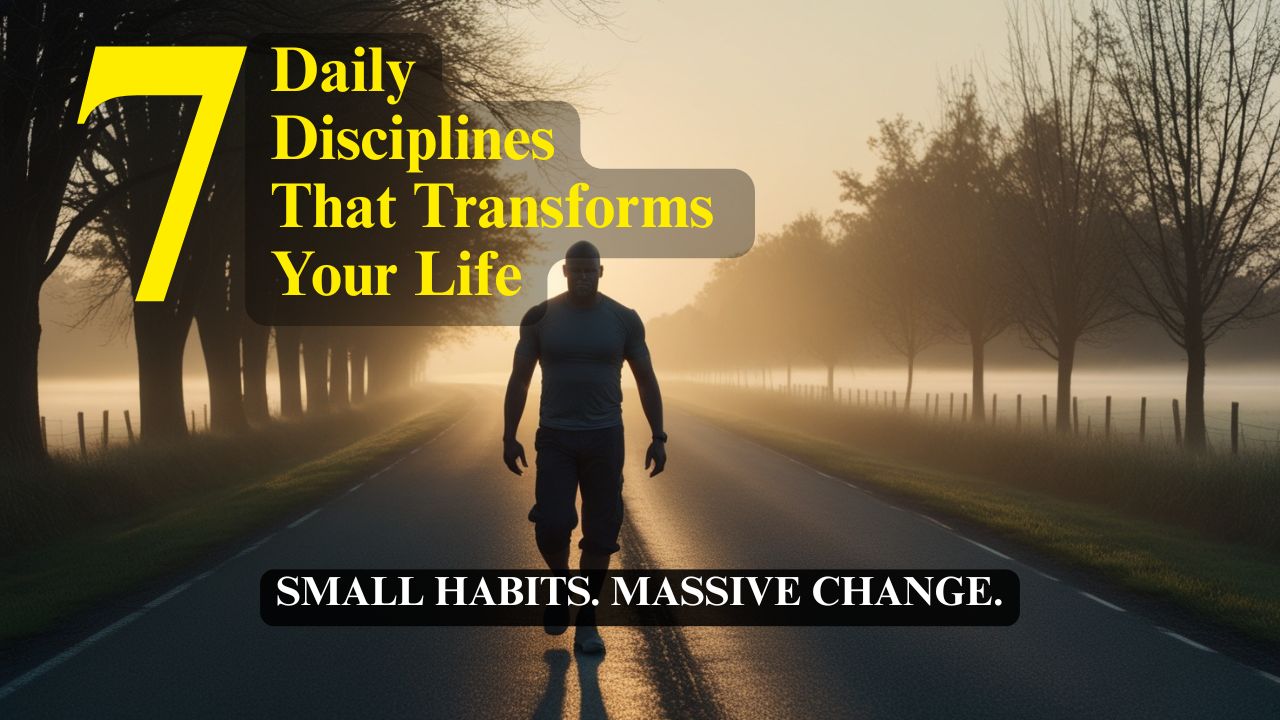
7 Daily Disciplines That Transform Your Life
The power to act with intention, to align your actions with your values, and to move steadily toward a life of purpose—even on days you don't feel like it.
Read Full Article
How to Build Unbreakable Discipline
Discipline is built—habit by habit, choice by choice, day by day. And the most powerful kind? The kind that doesn’t crack under pressure. The kind that becomes part of who you are.
Read Full Article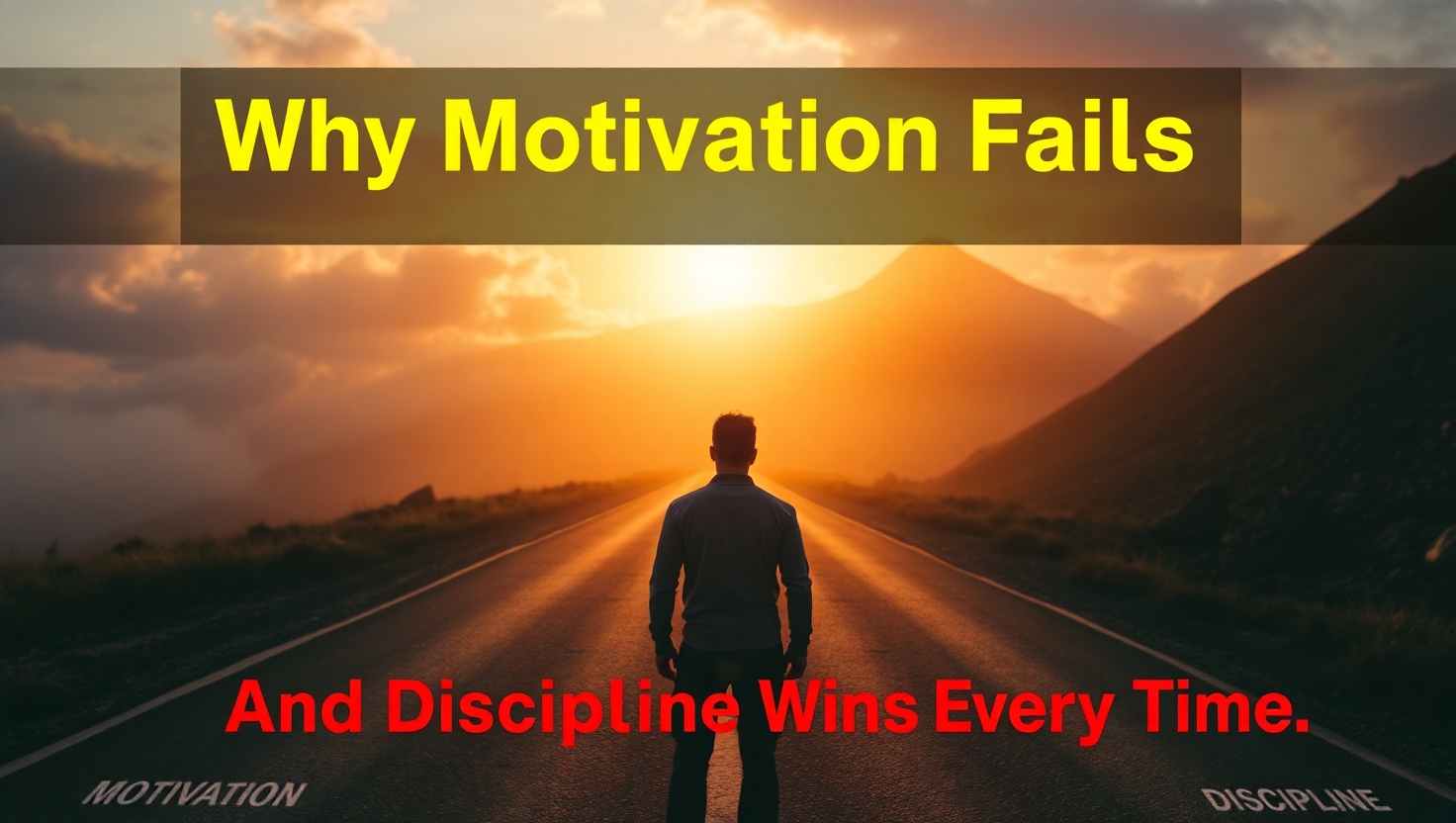
Why Motivation Fails And Discipline Wins Every Time
We all love the feeling of motivation—that surge of energy, that rush of inspiration that makes everything seem possible. But here’s the problem: motivation is unreliable. It’s emotional. It comes and goes. And if your goals rely on you “feeling like it,” you’re already in trouble.
Read Full Article
Discipline Over Desire
Desire is loud. It burns bright, talks fast, and loves to dream. But desire alone doesn't achieve much. Every person has desires. Very few have the discipline to bring them to life.
Read Full Article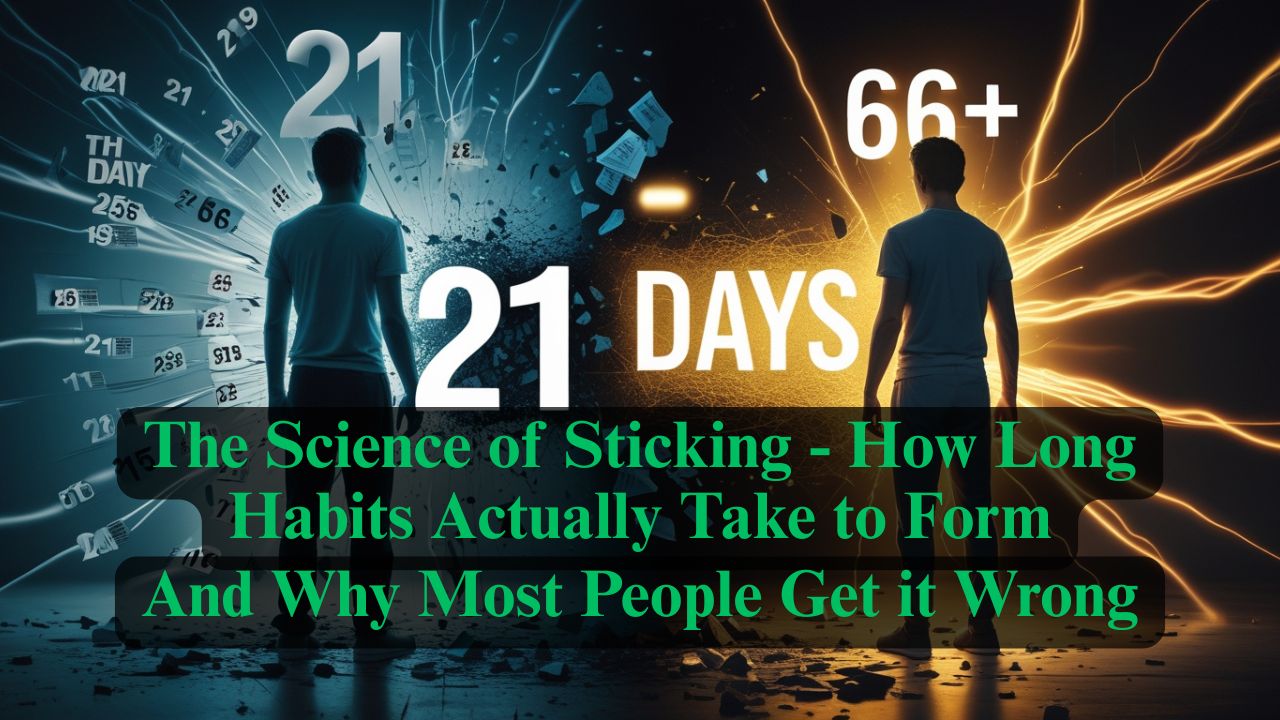
The Science of Sticking
If you've ever tried to build a new habit, you've probably heard that it takes 21 days. This number gets thrown around so often that it feels like scientific fact.
Read Full Article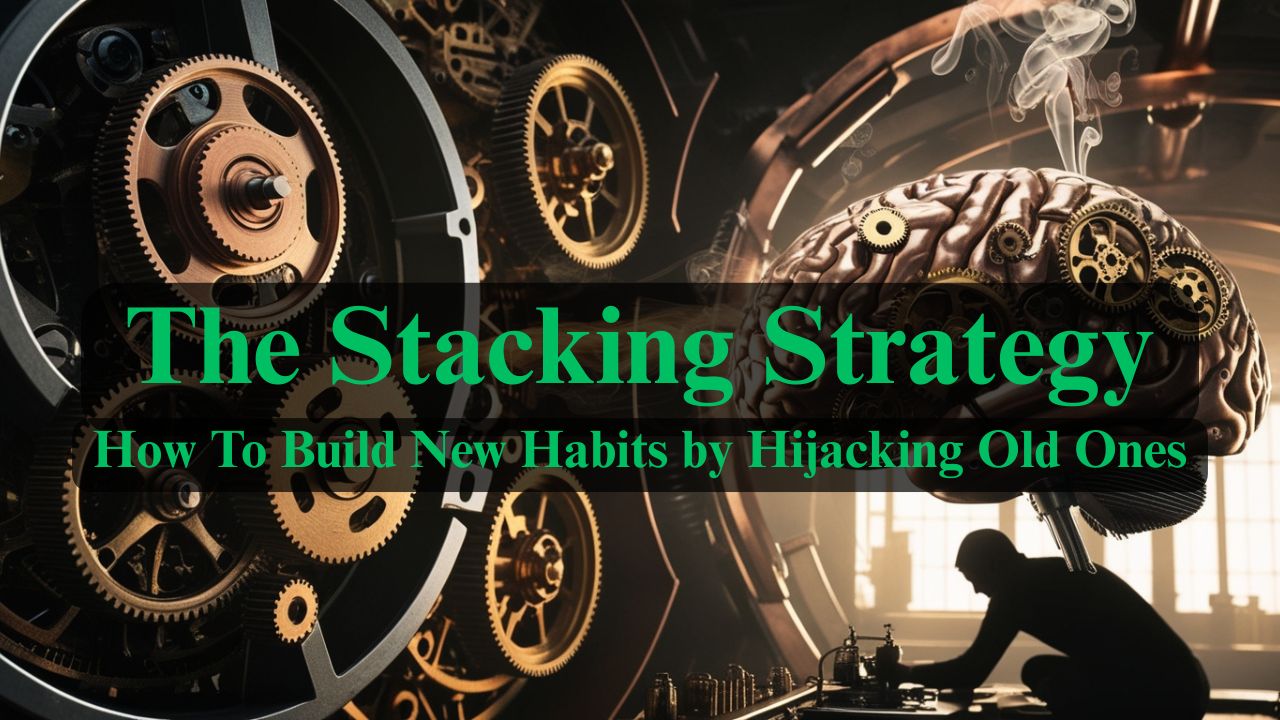
The Stacking Strategy
What if I told you that the habits you already have—even the ones you consider "bad"—could become the secret weapons for building the habits you want?
Read Full Article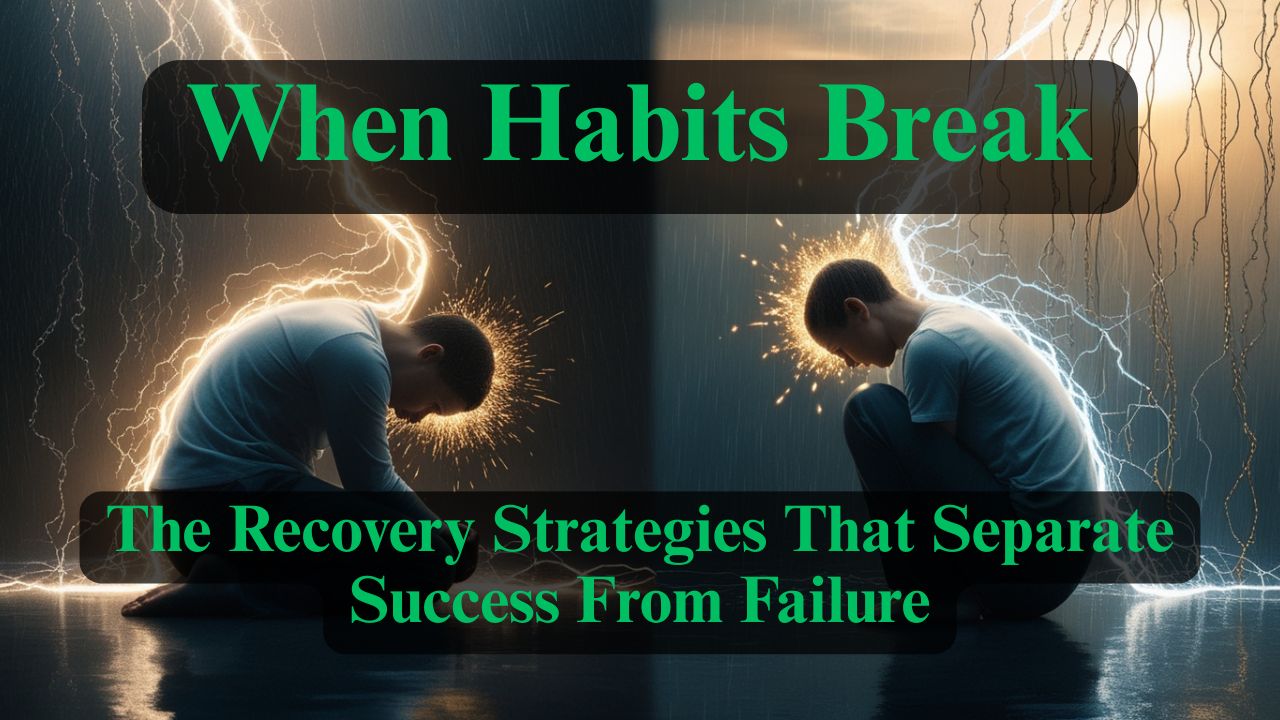
When Habits Fail - The Recovery Strategies That Separate Success From Failure
Here's what nobody tells you about building habits: you will fail. You'll miss days. You'll fall off track. You'll have weeks where everything falls apart.
Read Full Article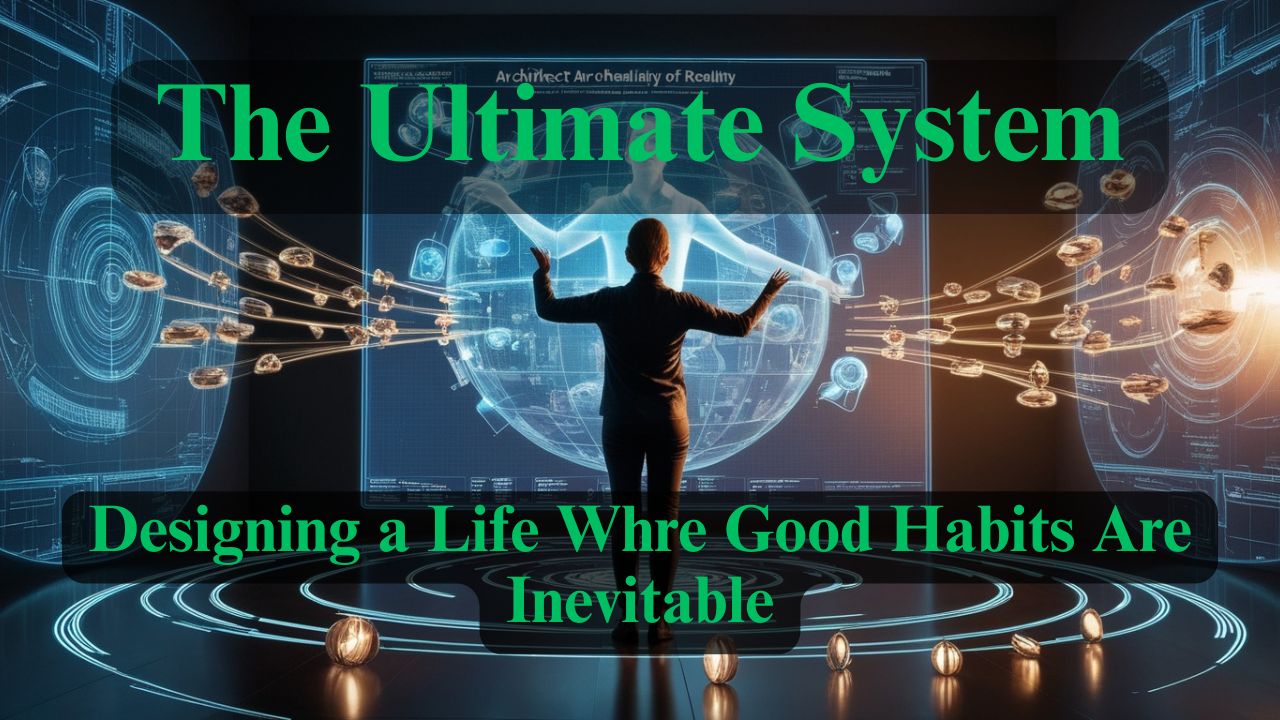
The Ultimate System - Designing a Life Where Good Habits Are Inevitable
You've learned to recognize habits, understand their formation timeline, stack them strategically, and recover from setbacks.
Read Full Article
